Comment: The following account is by an American who visited North Korea in 2015. As you'll see, the country is certainly strange in some respects, but by no means the monstrous hell-hole it's been uniformly portrayed as in Western media-culture.
Only about 750 western tourists visit North Korea per year, so when you confess to friends that you are voluntarily vacationing in the world's most notorious dictatorship, they tend to be taken aback. Some would ponder, "Why would you go to North Korea?" while others were more blunt: "Why in the holy living f*$k would you go to North Korea?" After a while, I just said Korea without the geographic clarifier, which quelled some concern.
I've always liked traveling to the weird ends of the world. Paris and London are great, but I have gotten a peculiar joy out of the off-the-radar places too: walking streets in Bosnia pockmarked with bullet holes, crossing the border into the hard-line communist country of Transdniestria which remains unrecognized by the UN as an actual country, or wandering through Osama Bin Laden's home town in Saudi Arabia. I like all places scrappy, strange, and overlooked, and North Korea certainly fit the bill.
I am also fascinated by the Cold War, spawned by a visit to Berlin a decade ago, where some scars remain in a city carved apart in 1945 by the mutually-suspicious victors of World War II. My interest in the Asian theatre of the Cold War grew after reading Barbara Demick's phenomenal book Nothing To Envy: Ordinary Lives in North Korea, which gave me my first glimpse into Korea, another nation haphazardly divvied up between the Soviets and the West. Unlike East and West Germany, however, the two Korean nations remain separate today, and unlike anywhere in Europe, the Cold War became hot in 1950 during the Korean War.
Since the war's stalemate in 1953, the two Koreas have grown further apart culturally, economically, and even linguistically. Korea is among the final places in the world where Cold War tensions are alive, with millions of soldiers, land mines, and munitions spread on both sides of the famous Demilitarized Zone (DMZ), a misnomer if there ever was one.
Many people wrongly believe that North Korea—officially called the Democratic People's Republic of Korea, or DPRK—is completely closed to foreign tourists. The truth is that it's quite easy to get into the country, assuming you are willing to do some coordination and visa paperwork in advance. You are required to go with a guided group tour, however, and there are only a few to choose between. I picked a company called Young Pioneer Tours, which seemed the most suited toward my travel style, which is decidedly group-tour averse.
For US citizens, the reclusive nation has only been open since 2011, but most people from the West have been able to travel there for a decade or more. According to our Young Pioneers guide, of the less than 1000 western tourists who venture to North Korea each year, roughly 20% are American, likely making me one of the first few hundred American tourists to visit.
Almost every foreigner venturing into North Korea travels overland by train from Beijing to Pyongyang. Inexplicably, Americans are barred from train travel across the border, instead required to fly into the country to meet the rest of their group. The idea of flying to North Korea by myself was seriously unnerving, so I opted for an unorthodox 7-day tour starting in faraway Malaysia, so I could fly in and out of the country with my entire group.
Departure & Arrival
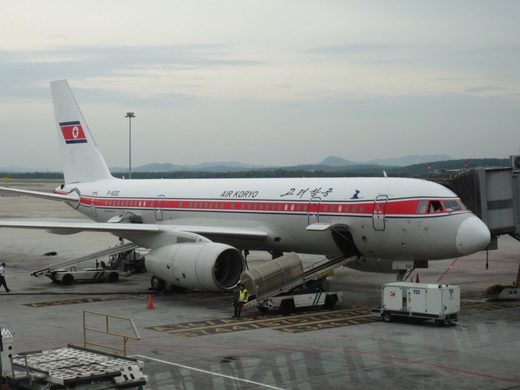
One by one, I was joined by the people with whom I would spend the next week. My group included a set of experienced intrepid travelers from Australia, New Zealand, France, Switzerland, and Singapore. There was also a 70-year-old British man named Billy, with copious tattoos and an accent so thick he bordered on incomprehensible. (He spent most of the week joking with me about how I was a no-good Yank.) Joining us was a random group of Indonesian people who seemingly had chosen to come to North Korea on a whim only a few weeks earlier. The biggest surprise was a sweet and seemingly conservative 50-something American couple named Tom and Gayle, who were on their second trip to the country, their first to the rarely-visited northern part of the country around the city of Raison.
It takes a weird breed to want to go to North Korea, and it was a charmingly incongruous bunch. Mr. Pak distributed our visa paperwork, and sent us off through security toward our gate.
As we walked down the jetway toward our worn Russian-made plane, our group was greeted by a prim and proper flight crew from Air Koryo, the government-run national airline. I suspect this crew is among the few North Koreans who have ever left the country.
We settled in, buckled up, and the crew handed out the English-language propaganda paper, The Pyongyang Times, which contained dozens of repetitious articles about young leader Kim Jong Un inspecting various plants and schools, plus a handful of pieces about winning the war against the slimy American imperialists, as if this had happened yesterday rather than sixty years earlier. I glanced up from the paper at the airline safety video, which starred the exact same flight attendants who had greeted us minutes before. It made me wonder how many commercial planes there are in North Korea. Was this... the plane?
Traveling frequently for work, I find being on a plane to be a fairly trivial experience, but being on a North Korean plane was nerve-wracking as hell. Every jolt of turbulence felt like it would be life-ending, every adjustment in air pressure like an inevitable path toward suffocation or cranial explosion. We distracted ourselves by chatting, sleeping, and drinking the local Taedonggang beer. Sound from a repetitious anime cartoon blared from the tinny speakers on the TVs overhead for the full seven hour flight.
We touched down into a thick gray mist, obscuring any glimpses of the country from the windows. Preparing to exit the plane, we nervously mumbled pleasantries to each other as we grabbed our bags and walked into the unknown. I glimpsed the gray ramshackle control tower attached to the impossibly dumpy Pyongyang airport, and marking the path ahead the terminal were dozens of soldiers donning olive green fatigues and holding rifles. It finally became real. Holy... shit... I am in North Korea.
I shuffled toward the gate where the stern immigration officers checked our passports, and my navy blue American passport rapidly started to feel like a serious liability. When it was my turn, I stood nervously as the morose officer checked my paperwork for a few minutes, then unceremoniously handed me back my passport and visa. I had made it in.
In the past, any dangerous contraband brought in by foreign travelers—mobile phones, GPS-enabled cameras, newspapers, and books—would be confiscated as you passed through customs, then given back as you left the country. The rules became increasingly lax during the course of 2013, with reports that phones and non-offensive books were being allowed through, potentially a sign of some thaw in historically icy relations with western tourists. I left anything even remotely controversial at the airport in Kuala Lumpur, but I did bring my iPhone, which was confiscated for a few minutes by curious guards, documented carefully, then returned.
Despite going on the trip with a western tour company, all tours in North Korea are run by the official government-run tour agency called KITC. Just past security, we were greeted by our squat and scruffy British guide named Gareth, the owner of Young Pioneer Tours, as well as Kim and Lee, our two chipper North Korean guides. To make going to North Korea seem more dramatic and dangerous than it is, these guides are often called "minders" by travelers, and people claim that KITC provides two guides so that each can watch the other for signs of any corruption by outside influence. That may contain partial truth, but Kim and Lee really seemed like guides, not guards. They were young, smart, unabashedly proud of their country, and eager to show it to us.
Night fell as we piled on our tour bus and headed through the wide streets of Pyongyang, which were shockingly dark and empty for such a big city, making me remember satellite photos of the country from space, largely shrouded in darkness.
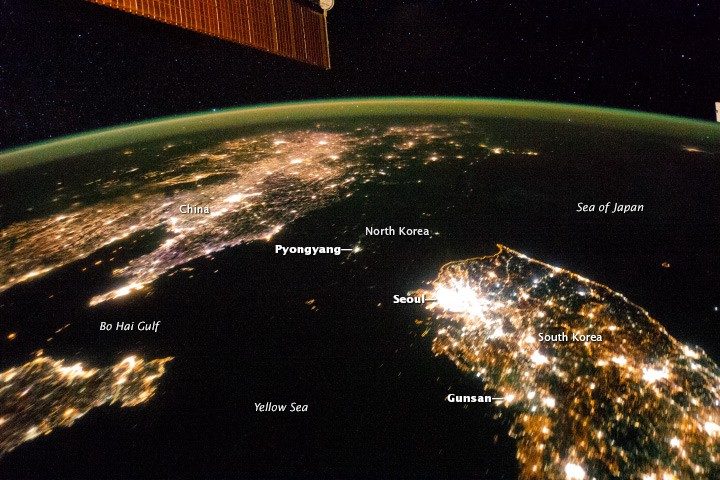
An hour later, we arrived at Yanggakdo International Hotel, the most common place for foreign tourists to stay in the city. Gareth gave us a tour of the hotel, which had a bevy of amenities ranging from the normal pool and hot tub to the more quirky: a bowling alley, a karaoke bar, an extremely sketchy basement casino, and a massage parlor which catered to "tired Chinese businessmen," which seemed to be a cheeky way of saying that the place specialized in handjobs.
The hotel had few ways to get in contact with the outside world. It offered basic services allowing you to send a postcard or make an expensive call to select foreign countries. Surprisingly, for a steep fee, you supposedly could write a message, give it to the hotel, and have them send it from their email account. The Internet is effectively non-existent in North Korea, and this was the only internet-connected computer I heard about during my stay.
I shared a room with Andy, an likeminded and well-travelled Aussie who does technology and behind-the-camera work for a TV station in Sydney. Our room reminded me of the crummy hotel rooms common throughout China, despite the Yanggakdo being one of the nicest hotels in the country.
A handful of us went for beers in the somber and dated revolving restaurant perched atop the hotel. Gareth, our British guide, sat with us like a reluctant drunkard in a press conference, answering our onslaught of questions about the country with surprisingly candid frankness. He seemed completely unafraid of anyone overhearing him, indicating to me that the hotel must be a relatively safe place to talk openly—at least by North Korean standards.
One of us asked a question with the underlying premise that North Korean people are effectively brainwashed. Gareth quickly snapped into a mode which intrigued me: he flatly rejected our assumption that North Korean people could be classified so easily, and gave us some personal stories about the deep thinking he had personally witnessed local people exhibit. Gareth's tone that first night was reinforced later in the trip: he certainly finds the country to be wacky and strange, yet he has a deep respect for the people and their prideful self-made culture. He encourages travelers to not simply see the country for its bizarre surface strangeness, but to dig deeper. And he would know: our tour was Gareth's 46th trip to North Korea.
Great Leader & Dear Leader
Our first full day was spent on a whirlwind tour of sights in central Pyongyang, hopping in and out of our air-conditioned bus along the way, getting glimpses of the fascinating city enveloped in the morning sun.
Bulky soviet-style apartment blocks lined each street. In lieu of stoplights, uniformed female traffic cops robotically swung batons to guide buses and cars across massive intersections. Rickety trams chugged along, packed with people on their way to work, curiously looking at the busload of foreigners driving past. Cheerful paintings of Kim Jong Il and Kim Il Sung smiled down from massive propaganda posters lining most streets.
We stopped to see the enormous bronze statues of the Great Leader Kim Il Sung and the Dear Leader Kim Jong Il, perched on Munsudae Hill overlooking Pyongyang. As instructed by our guides, we marched in-stride toward the statues, came to a stop, bowed three times, then one of us presented a few bouquets of flowers we bought to pay respect to the leaders.
These statues were the siteof the boisterous tear-soaked mourning after the deaths of Kim Il Sung in 1994 and Kim Jong Il in 2011. In a country obsessed with its leaders, often treating them like god-kings, these two statues felt like the spiritual heart of Pyongyang. Seeing the statues in person was so surreal and different than anywhere I had ever been that it gave me butterflies in my stomach.
Munsudae Hill was our first exposure to regular North Korean people up-close. Like many places I have visited, we were embraced by curious kids and widely ignored by most people over 13 or 14 years old. Particularly in Pyongyang, people seemed like they had at least seen foreigners before and were desensitized enough to not gawk, point, or even make eye contact.
Although the people seemed poor by modern global standards, it definitely felt like people in Pyongyang were the lucky ones — well connected elites, or at least the equivalent of an upper middle class. There was an unexpected hustle-and-bustle in Pyongyang that felt of a different era, like being immersed in an elaborate movie set depicting a newly-constructed socialist metropolis. I had to keep reminding myself it was 2013.
It was clear almost immediately that the Great Leader and Dear Leader have permeated into every aspect of modern life in North Korea, both ideologically and visually. Their pictures are everywhere, from massive murals along many streets to small portraits hanging at the top of almost every room we visited during the seven day trip.
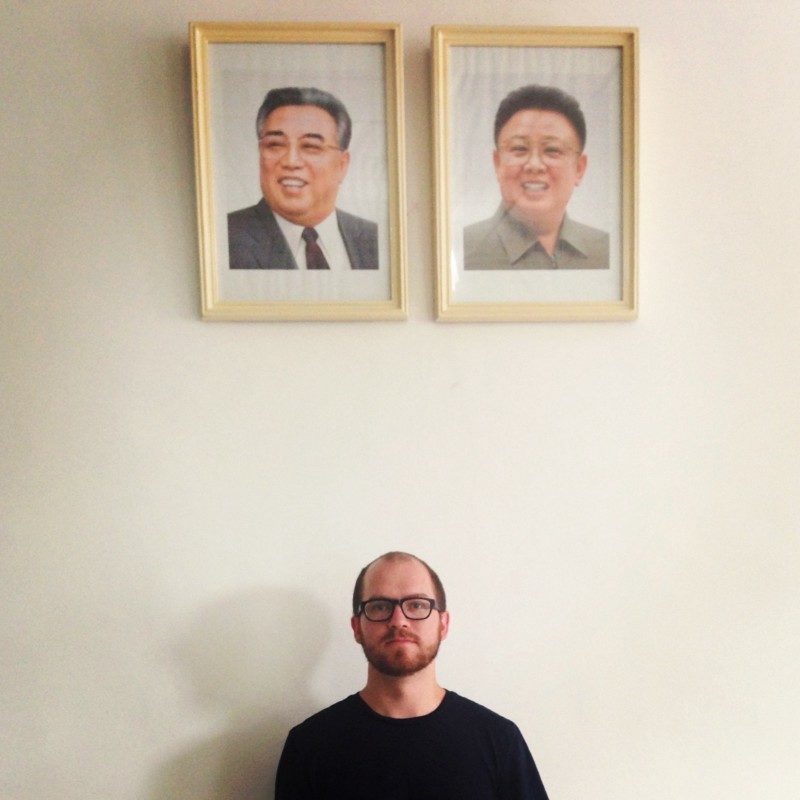
That afternoon, we toured the extensively renovated and newly-opened Victorious Fatherland Liberation War Museum, which provided my first big dose of reality when it came to North Korea's perception of the United States, at least militarily.
I was surprised to find that people in the DPRK seem to think about the Korean War constantly. Our tour guide described the United States not as their long-ago wartime foe, but rather as the sole roadblock standing in the way of a united Korean peninsula. Amazingly, they see the United States troops on the south side of the Demilitarized Zone as symbols of the disgusting brainwashing and enslavement of the impoverished and unlucky South Koreans. As people spoke about the the eventual unification of Korean peninsula, it was always described in terms of freeing the South from capitalism and oppression, letting them escape the mighty grasp of the United States, not the other way around.
Comment: North Koreans' perception of this is the one that is more in line with objective reality.
Often called The Forgotten War in America, I'd guess that 90% of Americans couldn't even tell you what the Korean War was fought about, who started it, or who was on each side. Not so in North Korea: the war is a national obsession, and seems to be at the top of mind at all times. The government has convinced citizens to be relentlessly weary of an attack on them by the US, and it has built up the fourth largest army in the world in preparation for the inevitable invasion, sure to come any day now.
Comment: Well, the US government sure generates that impression.
A trip to the War Museum begins with the Captured Weapons Exhibition, which is a collection of confiscated American military gear—machine guns, helicopters, jeeps, and even tanks—proudly flaunted under a large outdoor garage. The crown jewel in the collection of captured contraband is the USS Pueblo, a Navy ship encircled and captured by submarines in 1968 after it allegedly entered North Korean waters on a spy operation.
The Navy crew on the USS Pueblo was held captive in the country for 11 months. Despite being terrified, the American crew seemed hellbent on sassing their North Korean captors, flipping the bird whenever the group was photographed, cheekily claiming it was a "Hawaiian good luck sign."
Despite the US claiming that the Pueblo was in international waters at the time of the incident, the United States officially apologized after the long stalemate in an attempt to bring the troops home. This delighted the North Korean government, who viewed the apology as a massive victory against their biggest foe, blending nicely with the story they had been weaving about the evils of US imperialism. I was surprised how much of the tour focused on this US admission of guilt — even 45 years later, they are giddy about this incident, long forgotten in America. Of course, there was no mention that the State Department retracted its apology immediately after the troops came home, or that the soldiers purposefully put jokes into the apology, calling Washington "naughty" and using sexual overtones to describe their crime: "...these transgressions into the territorial waters of this sovereign peace-loving nation matter because penetration, however slight, is sufficient to complete the act."
Comment: A very telling difference between East and West.
Inside the newly-remodeled museum, we were greeted by a several-story tall statue of portly Kim Jong Un and informed that photographs are strictly forbidden inside. The museum was surprisingly well-done, albeit in a bizarre authoritarian way, with a genuinely spectacular array of realistic life-size dioramas of war scenes, including an amazing area which simulated walking down a half-bombed side street in Seoul.
We happened to move through the museum alongside a group of uniformed North Korean soldiers, which added to the realism. The final display in the museum was a huge and harrowing battlefield scene, where the realistic wax bodies of dozens of dead Americans lay strewn around a field. Standing over the bodies were a few surviving American soldiers, gaunt and ugly with large Roman noses, staring out at museum-goers. I froze as one of the North Korean soldiers sauntered up and stood face to face with the wax American soldier, staring his enemy straight in the eyes with palpable disgust. The soldier paused there for thirty seconds, sneering face-to-face with the grotesque American. I couldn't look away.
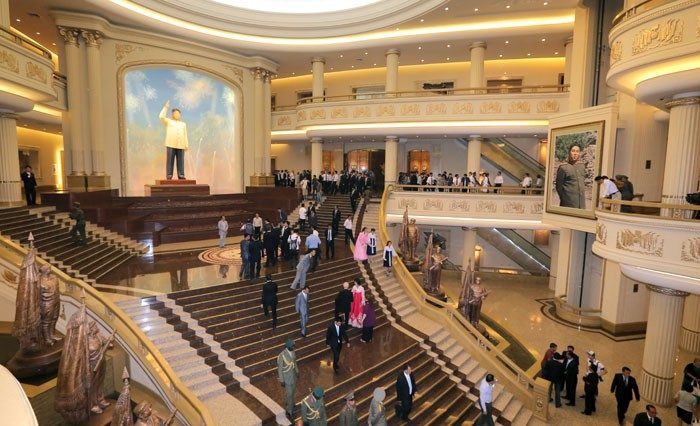
- They believe that the United States started the war
This is questionable logic, if only because the US was clearly not ready for any kind of military action in Korea. After the war abruptly began, it took three weeks to even get American troops mobilized to defend the tiny corner of Korea still under US control, the so-called Pusan Perimeter. Declassified documents from the Soviet Union show that Joseph Stalin was even surprised by Kim Il Sung's attack south, not to mention Harry Truman. Still, the official account in North Korea is that the US started the war, but then promptly began getting trounced by the North Korean army. - They believe they fought mostly alone
If you read accounts of the war, China played an essential part in the success of North Korea, effectively saving its neighbor from defeat. Chairman Mao's army was seasoned and tough from their fight against Japanese imperialism, and posed a much more significant challenge for the US Army than the North Korean troops. Yet, in Pyongyang's War Museum, China's sacrifice of one million troops to help its socialist neighbor barely even got a mention. Supposedly, when Chinese tour groups visit, they take them through a different wing of the museum which more overtly praises the Chinese for their help and sacrifice. - They believe they won the war
North Koreans take a lot of pride in "defeating" the Americans, but in my view, the war was a tie for both sides, at best. Millions of lives were lost with no real gain on either side. Still, the North Koreans are not entirely wrong on this point. As the US regained control of the war, United States General Douglas MacArthur famously over-reached far into the North, only to get beaten back by the Chinese Army as he approached their country's border, ceding a lot of land back to Kim Il Sung's control. In that sense, it was a North Korean victory because land north of the 38th parallel was in play.
Comment: What the author/traveler either does not know, or neglected to mention, is that the primary source of North Korean 'weirdness' towards the US is that US dropped more bombs on North Korea than during its entire WW2 Asia Pacific campaign. Up to a fifth of the North Korean population was incinerated. No building was left standing. The US literally wiped North Korea from the face of the Earth...
"After destroying North Korea's 78 cities and thousands of her villages, and killing countless numbers of her civilians, [General] LeMay remarked:~ Global Research"Over a period of three years or so we killed off - what - twenty percent of the population."It is now believed that the population north of the imposed 38th Parallel lost nearly a third of its population of 8 - 9 million people during the 37-month long 'hot' war, 1950 - 1953, perhaps an unprecedented percentage of mortality suffered by one nation due to the belligerence of another."
The East Coast
We ventured out of Pyongyang toward Wonsan, a town not included on most North Korea tours, located on the east coast of the Korean peninsula.
As we drove, Pyongyang's gray and towering apartment blocks rapidly gave way to dusty dirt roads and quaint farmland. We travelled on one of the country's most major highways, yet it was ill-maintained and looked like its best days were long behind it.
The scenes outside the bus window looked more like the Joad's farm in The Grapes of Wrath than the massive soviet collective farms I expected to see. Smoke spewed steadily out of military-style trucks ingeniously modified to run on plentiful firewood rather than expensive gasoline. Western accounts of the Korean War describe the country as being absurdly mountainous, and sure enough, over the course of our five-hour drive the farmland slowly transformed into rugged green mountains.
Just like any good road trip, we stopped along the way for drinks and snacks at a few quiet rest stops, seemingly built for the few foreigners passing through, each equipped with disturbingly smelly bathrooms, a shrine to the country's leaders, and a small shop with a modest selection of snacks.
Paying for anything is a bizarre and time-consuming experience in North Korea. Foreigners are not allowed to use the local currency, and are instead instructed to use Chinese Yuan, US Dollars, or Euros to buy anything. Any purchase seemed to result in 10 minutes of concerned scrambling by the store's attendant to find enough change to complete a purchase. On our way to Wonsan, I attempted to buy a local beer using Chinese Yuan. Ten minutes later I got my change: a crumpled up Dollar, a Euro coin, and a pack of chewing gum to compensate for them running out of change.
We arrived in Wonsan at the blocky and expansive main square which butts up against the Sea of Japan, unsurprisingly called the East Sea of Korea locally. Near the water were a group of women cooking eggs, eels, and other barbecued meat over small gas grills or open flame. Scrappy kids played improvised games in the rusty flotsam and jetsam that littered the concrete pier. Propaganda posters encouraged increased production and steadfast resistance to outside influence.
Kim and Lee announced that we would be hopping back on the bus for a few minutes headed to a stop nearby. Gareth, our British guide, pulled the local guides aside and skillfully bargained to let us walk on foot along the harbor. Kim and Lee were skeptical; this was not part of the predetermined plan. It was fascinating to watch Gareth push the guides to the edge of their comfort level, eventually convincing them to let our group walk through the city.
This walk was one of a handful of moments that felt very unscripted. Our guides were noticeably more tense, and were careful to keep the group together. Walking along bustling sidewalks for 45-minutes was fascinating, and we received much more attention than we had previously. Kids waved and screamed hello at us, and compared to any other place I saw in North Korea, the adults were curious, warm, and welcoming. Wonsan seemed gritty and raucous compared to the orderly capital, with a smattering of street hawkers selling a modest selection of food and clothing along the sidewalk. We were a long way from Pyongyang.
Out of nowhere, the most wonderful thing happened. They started singing to each other.
Their voices rose and fell, sometimes one person singing, sometimes all six. I clung to a rock and listened. There, in the far reaches of the world's most disconnected and repressive country, in the veiled darkness below a concrete slab, these people huddled around a fire, jovially singing songs to each other. It was a bright spot in a dystopian future.
I'm not sure why I was so compelled to go to North Korea, but I would go back again in a heartbeat if I could re-live the two minutes I spent listening to that family sing.
The next morning, we paid a visit to an inactive train station where Kim Il Sung visited at a time seemingly important to North Korean history. With the Great Leader's image pinned to her traditional gown, a cheerful local guide framed her tour around the Great Leader's activities. Here is where Kim Il Sung's train arrived when he visited Wonsan. Here is the hotel where he stayed. Here is where he slept. Here is where he sat. Here is where he ate. Here is where he wrote letters.
Seeing people so casually reverent and respectful toward dictatorial leaders was perplexing. How could people adore men who constructed a socialist economy that has left North Korea significantly more poor than their neighbors and families to the south? How could people still respect men who presided over a decade-long famine in the 1990s? How could they embrace leaders who purposefully kept people enslaved by their own ignorance, disconnected from people and information in rest of the world?
Comment: Maybe because they don't see their situation that way? Maybe because they weren't brutal dictators but well-loved leaders?
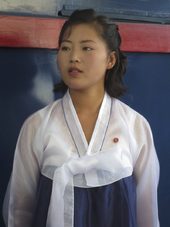
Comment: Key detail missing here: Japan took over Korea with Uncle Sam's (and Britannia's) blessing, on the way to launching war on Russia. And thus began the imperial Japanese monster.
Kim Il Sung was born in 1912. At that point, Japan already had a decade of exploiting the Korean people economically. By the time the Great Leader was a teenager, Japan was beginning to infiltrate culturally, even going so far as to enslave, rape, and kill ethnic Koreans. As he began to fight Japanese imperialism in the 1930s and 40s, it's easy to see how Kim Il Sung's words would have been legitimately inspiring to Koreans. His words became linked with what it meant to be Korean, and therefore what it meant to be free. We sometimes emphasize his firmly-held belief in Lenin-style socialism, but it was Kim Il Sung's words of nationalism, not his belief in a new economic foundation, that spread his message to ordinary Koreans.
The oppressed peoples can liberate themselves only through struggle. This is a simple and clear truth confirmed by history. —Kim Il SungFor the first decade or so of North Korea's existence as a country under Kim Il Sung, life was legitimately better for regular people than it was under Japanese occupation. For a few decades after the war, they even fared better economically than their southern counterparts. The North Koreans had a common purpose: to rebuild the country better and stronger than it was before, and hardcore socialism was an effective vehicle for accomplishing that goal. Like Europe rebuilding after World War II under the Marshall Plan, some of these big government-driven approaches to reform and reconstruction were wildly successful.
People
In the afternoon, we went to an oceanfront area in Wonsan cordoned off for foreigners, sandwiched between beaches packed with lucky locals enjoying a day off from work.
Out in the water, we saw an enormous diving platform made of wooden planks, neglected and dilapidated, with easily half of the planks completely rotten or missing entirely. Its ladder broken, we spent twenty minutes trying to boost each other up onto the platform, spiky barnacles and rusty rebar slicing into our feet, blocking our ascent. A handful of jovial locals saw us swam over from the public beach and easily hoisted themselves up onto the platform, laughing and roughhousing, expertly tiptoeing across the ramshackle diving platform and swan-diving into the water.
In many ways, our tour was designed to keep us separate from regular citizens of the DPRK, and I cherished these moments of actual interaction with real North Korean people, even though they were brief, infrequent, and largely inconsequential.
Back on the beach, we found ourselves in a shower room along with a few local men from Wonsan. The water in the showers wasn't actually working, which prompted one of the men to wordlessly mime about the situation. With a broad cartoonish smile, he twisted knobs, looked up at the dry shower head, looked back at us, twisted the knobs of another shower, then looked back at us bemused. He pointed a finger in the air as if to say Aha! I have a solution to the shower problem!, then walked over to a nearby bucket of water and dramatically dumped it on his head. It was like a schtick from an old slapstick movie, and we foreigners laughed along with the local men.
Earlier in the trip, people in our group were piling into an elevator with some locals, and a decidedly rotund member of our entourage stepped on, causing the elevator to buzz angrily at the excess weight. In a defiance of political correctness, the North Korean people almost lost their minds laughing. The elevator thinks this foreigner is too fat! Priceless!
As minor as these moments seem, they were glimpses into a sense of humor and humanness that gets completely eclipsed by the militaristic demeanor of the country's leadership. There are real people in North Korea, and they are just as silly and funny as anybody else. It was a dimension of the country that I did not expect to see firsthand, but it was a welcome surprise.
Strange sights
Back in Pyongyang, we took a few day trips outside of the city proper, touring a smattering of wacky socialist sights, factories, and farms, providing an interesting glimpse of how the country projects itself to foreign visitors.
Up in the foothills outside Pyongyang was an enclave featuring gifts given to the DPRK by people of Korean descent from around the world. Some artifacts were genuinely awe-inspiring, including paintings and sculptures ranging from abstract and modern to traditional and representational.
The exhibition also proudly displayed objects that were a far cry from something you might expect to see at the Louvre: a handful of everyday coffee mugs commemorating Broadway shows like Les Miserables and the Phantom of the Opera, a broken digital alarm clock flashing 88:88, and some mid-90s inkjet printer drivers. Much of the museum felt like it displayed items chosen at random from my uncle's house rather than precious or unique objects. My personal favorite object in the museum was a massive hyperrealistic painting of a homoerotic-looking Kim Jong Il riding a sassy Siberian tiger through the snow, which made many of us awkwardly guffaw when our guide revealed it to us.
Bizarre places like this were nearly a daily occurrence on our tour. A few days later, we visited a truly miserable science and technology museum housed in a concrete building shaped like Saturn, with rings and everything. On the ground floor, a large exhibition hall flaunted recent technological innovations, including some newfangled invention called the "CD-ROM," which is apparently the greatest thing since the floppy disk.
Following in the footsteps of Kim Jong Il, we also were invited to tour and inspect some factories and farms. We visited a mineral water factory, where we got an inexplicable explanation of how the factory worked, and even got to sample the output. Later, we stopped at the Chongsan Cooperative Farm, where workers labored away digging and plowing, tending to the agriculture. The farm was one of many places where we were asked to bow to a statue to show respect to Kim Jong Il and Kim Il Sung. The handful of Indonesian people in our tour group opted out of visiting these places for religious reasons, seemingly nonplussed by how many sights they missed because of this. I couldn't help but wonder why they even came to the country — a big part of traveling in North Korea is demonstrating faux-reverence to its leaders.
In each place we stopped, guides shared stories and pictures of times when the country's leaders had visited, often delivering on-the-spot guidance, a bizarre tradition in which the Kims pontificate about how the place could be run more efficiently, down to the extreme minutia of what products a factory makes, or how it is run. This guidance further reinforces the notion that the country's leaders are all-knowing and god-like.
In downtown Pyongyang, we visited the main city hospital which boasts a shiny new wing, purportedly designed with heavy input from Kim Jong Un himself. While the wing did have a few pieces of modern equipment, the hospital was incredibly dated, and most rooms were dark and musty, walls filled with what looked more like tinctures than modern medicines. We were suited up in white lab coats and led by a few doctors and nurses on a tour, which mostly consisted of us awkwardly barging in on people's doctor and dentist appointments — a woman getting a cavity filled, or a pregnant woman in the middle of a prenatal checkup — and encouraged to get close to the patients to snap photos.
Coming from a society obsessed with individual privacy, it was a bit of a shock. The people we observed seemed so unfazed by a gang of foreigners intruding on their doctor's visits that a few us got the suspicion they might actually be actors, only present for our visit. It was hard to say for sure, and I tried to lag behind the group to sneak glances in other rooms to get a sense for what else was going on in the hospital, and my overall feeling was that what we were seeing was all pretty legitimate.
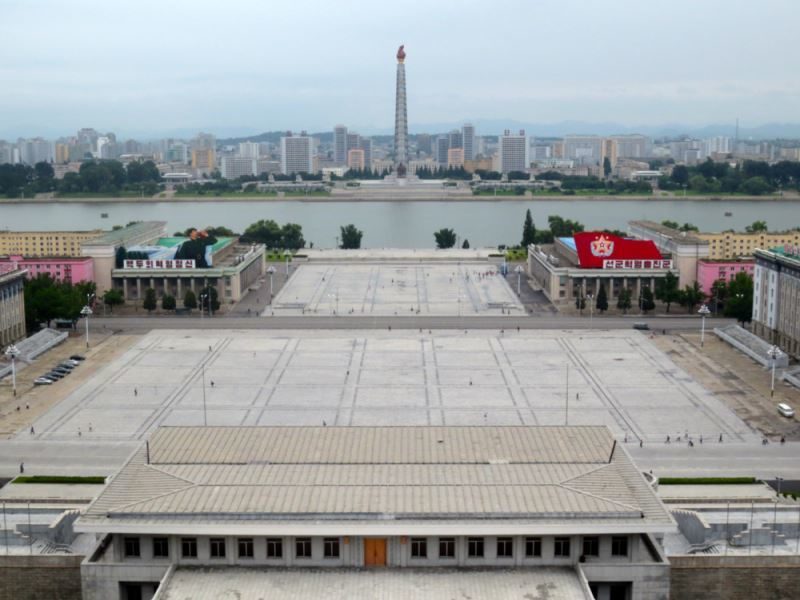
One problem: No one was actually doing anything. A few scrolled or clicked, but the rest just stared. More disturbing: when our group walked in—a noisy bunch, with media in tow—not one of them looked up from their desks. Not a head turn, no eye contact, no reaction to stimuli. They might as well have been figurines. [...] Were they really students? Did our handlers honestly think we bought it? Did they even care? Photo op and tour completed, maybe they dismantled the whole set and went home.
Comment: She would spin it that way, wouldn't she!
We encountered similar computer labs at the Grand People's Study House, Pyongyang's massive central library branch, and Sophie's observations made me hypersensitive to people's interactions with the computers in the lab. To my surprise, everything felt legitimate: people seemed to really be typing, searching, clicking, and reading. As far as I could tell, nobody was an actor.
We were given an explanation of the computers and the country's modest Intranet, which felt akin to electronic card catalog libraries used in my elementary school during the 1990s. Our tour guide asked my roommate Andy to sit at the computer and try to search for a book — evidence that they have notable foreign books in their stacks. He typed Alice in Wonderland, which came up in the directory, much to the glee of the guide.
The tour moved on, shuffling across the room and Andy, still seated at the computer, got a weird look on his face. In a potentially reckless move, he backspaced and quickly typed in "Orwell" into the search box. Amazingly, George Orwell's anti-authoritarian Animal Farm showed up, but there was no sign of 1984, arguably a literary prophecy of North Korea itself.
All books are equal, but some books are more equal than others.
My favorite room in the Grand People's Study House was the charmingly dated Media Room, where 1990s boomboxes sat atop every desk, one ominously blaring Yellow Submarine by the Beatles. The room seemed devoid of headphones, which made me wonder what happened when more than one person wanted to play music. We also swung by an English language class, where people stood a the front of the dark room waiting for their turn to mumble phrase into a microphone in incomprehensibly broken English.
Another surreal place in Pyongyang is less subtle: the 105 story pyramid-shaped Ryugyong Hotel. The building topped out in 1992 as a massive concrete shell, but due to an economic crisis caused by the fall of the Soviet Union, the building was not covered with windows until nearly 20 years later, in 2011. It is currently the 49th tallest building in the world, only a hundred feet shorter than the Empire State Building in New York. Amazingly, the building is almost completely vacant to this day, its opening delayed by political turmoil — and probably also a lack of foreign guests to necessitate such a behemoth hotel.
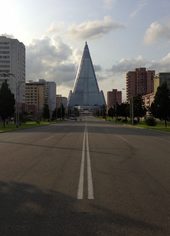
Even though we were firmly on the tourist trail, the place was surprisingly rough around the edges. At one point, I went to a zany circus performance and was allowed to venture into a cavernous basement bathroom without my guides. The power had gone out, and the bathroom was dimly lit by daylight pouring in from a few basement windows. The bathroom smelled rancid, and as I relieved myself, I noticed that the few dozen porcelain urinals simply dumped out directly onto the concrete floor, explaining the smell — the entire floor was covered with years upon years of dried urine. On my way back upstairs, I passed a North Korean man who held his nose jokingly, laughing and rolling his eyes at the condition of the bathroom. This was not the perfect and polished authoritarian country I expected.
Palace of the Sun
On the sixtieth anniversary of the victorious defeat of the Americans during in the Korean War, we ventured into the center of Pyongyang to visit the Kumsusan Palace of the Sun, a mausoleum housing the embalmed corpses of Kim Jong Il and his father Kim Il Sung, the infamous leaders of the DPRK.
Kim Jong Il passed away on December 17th, 2011, confirming the longstanding suspicion that the Dear Leader's health was in sharp decline after his publicly-announced stroke in August. Upon his death, Western media was inundated with bizarre footage of tear-soaked gatherings, as well as the surreal pomp and circumstance of the somber funeral procession through the streets of Pyongyang.
Upon the death of the Dear Leader, the media had an even larger event to cover: Kim's youngest son Kim Jong Un was announced as the patriarchal country's next leader a few years prior, but he was still a relatively unknown quantity. What kind of leader would he be? Would he be respected by the military hardliners? Would his two older brothers feel slighted that they weren't picked as the successor to the Kim dynasty? Would his time spent studying abroad in Switzerland or his love for the NBA have any impact on his relations with the West? Nobody knew for sure.
This was a first for the young country. By the time Kim Il Sung had passed away in 1994, his son and successor Kim Jong Il was widely known and respected within North Korea, and carefully monitored internationally. The West may have had concerns about Kim Jong Il, but at least they knew a lot about him by the time he became the ruler of the country. In the case of Kim Jong Un, the relatively unknown 28-year-old was thrust into the limelight as the supreme leader of a country which had proven its nuclear capabilities only a few years earlier. The world was afraid, and justifiably so.
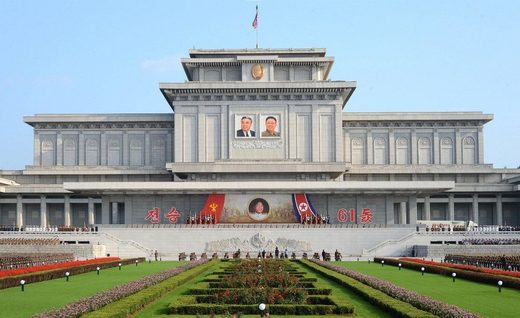
Upon entering the building, the place felt sacred and solemn compared to other places we had visited. I had seen Vladimir Lenin's mausoleum in Red Square, but visiting the Palace of the Sun was a much more complicated and elaborate process, with plenty of security, fanfare, walking, waiting, and prostrating to show respect. We were instructed to dress nicely for this visit, with many people in my group donning somber conservative dresses or shirts and ties. We had our cameras confiscated and went through several levels of security along the way, indicating more than anywhere we had been so far that this was not a visit to be taken lightly.
The building is divided into two identical wings, with each leader given an equal amount of prominence and respect. We were guided through hallway after hallway, with impossibly long moving walkways bringing us from one corridor to the next. As we journeyed through the building, we were passed in the other direction by an endless stream of military men wearing formal dress attire alongside their wives who donned elaborate and genuinely lovely gowns, sartorially somewhere between a kimono and a prom dress.
Overlooking the gaudy hallways were massive gilded frames lining the walls, each with photographs of Kim Jong Il and Kim Il Sung visiting factories, embracing Korean people, and more. I struggled to keep my composure because I recognized many of the photos from the delightful blog Kim Jong Il Looking At Things.
En route to see the leader's bodies, we stopped at Kim Il Sung's trophy room, where case after case bore what was surely the world's most rag-tag collection of awards. Even the guides seemed to have a rose-colored perspective on these truly ridiculous awards: the Lifetime Achievement Award from a socialist club in Oakland, California was described as "an award from the United States," which, while technically true, was a stretch. After the trophy room, we were taken to gawk at the Great Leader's black Mercedes, his boat, and his train car, each housed in its own room.
Finally, it was time to see the leaders. We were instructed to stand side-by-side in rows outside large double doors. Once situated, the doors were thrust open to reveal a long room, all marble and shine, pointing toward statues of the two leaders. I gasped in awe, then marched forward in lock step with my fellow travelers toward the statues. By that point in the trip, I had largely gotten used to being in North Korea, but walking down this hallway gave me an uneasy lump in my throat. I felt like I was in another time, a member of an untrusted delegation visiting a mysterious kingdom.
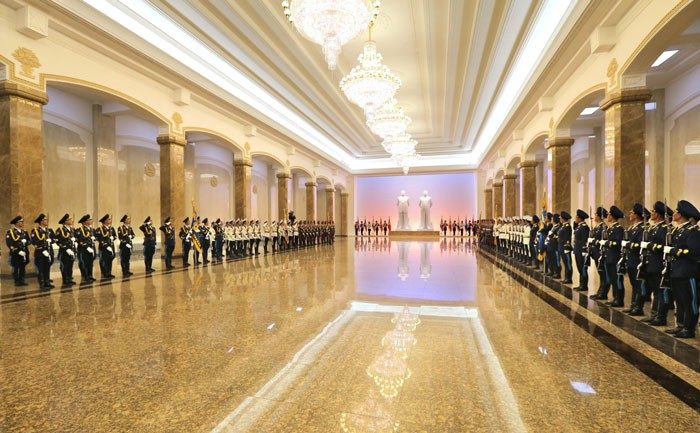
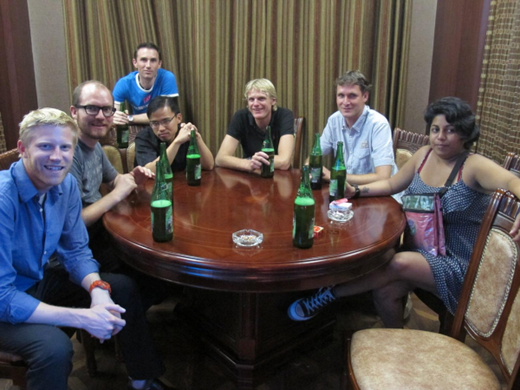
We shuffled out of the room and the whole process started over, except with the focus on Kim Jong Il instead of his father. It was surreal, because every place felt identical to the ones we had just visited: we visited the trophy room, saw his car, saw his boat, saw his train. There were several times where my brain couldn't comprehend that we were actually in different rooms than we had just visited. At the end, we stopped in a room to see the body of the Dear Leader himself.
Much more than other embalmed communist leaders — Mao Zedong, Vladimir Lenin, or Ho Chi Minh — Kim Jong Il has been a prominent figure in the news during my lifetime. It was flabbergasting to see him in the flesh, even posthumously. His head rested on a plush red pillow and his face looked swollen and old, yet totally familiar. Even in death, he wore the drab olive jumpsuit he famously wore in public, his portly stomach intact.
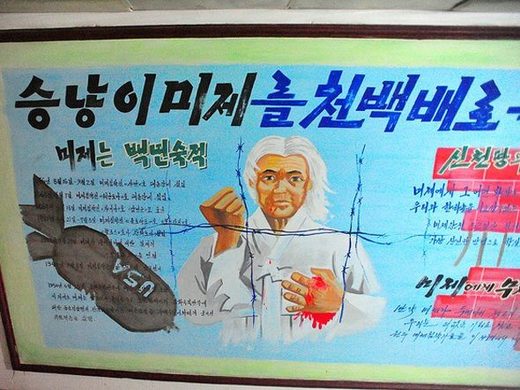
Foreigners
After hitting the sights hard every day, we would head back to the hotel where the few dozen tourists in Pyongyang would gather for an often boisterous night of drinking, smoking cheap cigarettes, and swapping stories from our travels.
The scene at the hotel reminded me of stories from journalists during the wars in Vietnam or Bosnia, where foreign beat reporters retire to their hotel enclaves each night to chit-chat and trade anecdotes from the day. Whether true or not, the hotel felt completely insulated and protected from the repressive country outside its doors. The hotel is situated on a small island in the center of Pyongyang, and heavily guarded to make sure foreigners do not wander into the city unaccompanied.
One night while drinking in the hotel bar, I got word that a reasonably cute Russian girl from another tour had taken a liking to me, and she wanted to go walk around the parking lot outside the hotel. I accepted, if only out of curiosity. She and I ventured outside into the darkness, and traipsed around the limited area where we were allowed to walk. She was tipsy and getting a little bit frisky, and let me know in broken English that she wanted to kiss me. Oh, but there was a catch! She insisted that she would only kiss me if we tried to escape from the hotel and go into Pyongyang proper, mingling with the locals, away from the repressive clutches of our organized tour.
I laughed. Was she serious? She was. In the back of my mind, this felt familiar somehow. And then it struck me: we were mirroring characters in George Orwell's dystopian novel 1984. She was Julia and I was Winston, and this was not going to end well for us. Big Brother was watching us.
We approached the outer gate of the hotel complex, and a sleepy guard stood up from his modest folding chair perch. He shined a flashlight on the two of us and signaled calmly that we could not go any farther. Suddenly, the Russian girl made a run for it. At full speed, she darted past the guard, across a bridge, and into the darkness of Pyongyang. I couldn't believe my eyes, and neither could the guard. This person was completely f*$king insane.
The stunned guard swung his flashlight back on me for a second. I put my hands over my head and indicated to him that I was absolutely heading back to the hotel, and that I posed him no threat whatsoever. I turned around and immediately marched back to the hotel by myself. He started chasing after the psychotic Russian girl. Her disappearance was extremely concerning to the western guides, who were drunk already for the evening and not sure what to do. People doing stupid things in North Korea put their tour company at risk, and they were less than thrilled about her disappearance.
Amazingly, the Russian girl returned to the hotel in the wee hours of the morning, claiming that she had spent a fantastic time cavorting around with the locals in Pyongyang. I'm not sure if she got in trouble officially, but for the rest of the trip I didn't say a single word to her, despite everyone referring to her as Ryan's Crazy Russian Girlfriend, much to my chagrin. Associating with her felt like an inevitable trip to a prison camp, so I gave her a wide berth and avoided eye contact whenever possible.
There was plenty of trouble to get into at the hotel itself, however. Thanks to a YouTube video popular among would-be North Korean visitors, suspicions abound about a staff-only secret floor of the hotel, totally closed to foreigners and full of anti-American propaganda. Suspiciously, buttons in the hotel's elevator jump from floor 4 to floor 6, and a stairway on the 4th floor inexplicably climbs directly into a solid wall. Our British guide Gareth indicated to us that the secret floor was very real, and that he had been there in the past, but that recently access had become more restricted. He implored us not to try to see it in person.
At 3am one night, a tipsy group of four people in my group decided to risk it and try to get onto the fifth floor. They walked down a housekeeping hallway and found a staff-only service elevator which had access to floor five. The elevator door opened and the space was dark and somber compared the rest of the hotel, walls painted with anti-Western propaganda posters to remind hotel staff that while they can be warm and inviting to the guests, that these foreigners remained the enemy.
They explored for a few minutes until suddenly a guard shouted at them from behind. Their hearts sunk; they were caught. They might get reprimanded, deported, sent to prison, or worse. Our North Korean guides, Kim and Lee, were woken up by the hotel's guards and staff, and the whole group was led up to the revolving restaurant on the top floor. As punishment, they had to write formal apology letters to the government, and they had all of their photos of the floor deleted from their cameras. Later in the week, their cameras were all confiscated again without warning and searched for photos of the fifth floor. Apparently, the angry hotel staff threatened to post their apology letter on the Internet as a way to shame the travelers, not understanding that would be the ultimate prize in Western traveler circles.
As a rare American in the country, I was hypersensitive about doing anything that could be deemed offensive to the government because I was legitimately terrified of getting imprisoned. I couldn't believe how many other travelers—even those in my group—seemed willing to risk their lives for a good story to tell.
My fears were not unjustified. In 2012, a Korean-American named Kenneth Bae was arrested by the North Korean government for allegedly crossing the border illegally, trying to spread religion, and plotting to overthrow the government. In early 2014, a tourist named Matthew Miller was arrested after he allegedly ripped up his tourist visa, apparently seeking asylum in the DPRK. Both men were imprisoned by the government and sent to labor camps, but eventually let go in November 2014 after a secret delegation was sent to Pyongyang by President Obama in an effort to free the men.
Traveling in the country felt totally safe — in many ways more safe than anywhere I had ever been — but the specter of a lifetime of imprisonment in a remote labor camp certainly hung in the air.
Isolated Together
One day, our group paid a trip to Kim Il-Sung Square, where periodically the government puts on a large display of its military prowess to impress and terrify the rest of the world.
Compared to the images I had seen on TV, the square felt desolate and lonely during our visit, with only a few people wandering through it. Curiously, the stones on the ground were littered with tens of thousands of cryptic arrows and undecipherable squiggles written in white paint. I asked our guide what they meant, and he indicated they were for major events to help people stand in their proper places during different parts of the spectacle. It struck me that these were akin to markings on a theater's stage, guiding actors from place to place during the duration of a play.
To me, the square was a paradox, a microcosm of the rest of the country. On one hand, these theatre-like performances seemed to indicate that North Korea has an intense wish to be respected, admired, and even feared by outside observers. They carefully control their perception to outsiders, down to the individuals performing in each event. On the other hand, their national mentality — called the Juche Idea—is one which embraces national isolation, rejecting any interest in foreigners at all.
The Juche Idea stems all the way back to anti-imperialist speeches given by an 18-year-old Kim Il Sung. Dozens of years later, as his anti-Japanese fervor turned into a tangible national government, the concept of Juche solidified and became widespread. In his speeches at the time, the concept is inward-looking, pushing Koreans to focus their attention on domestic concerns in an increasingly globalized environment:
To make revolution in Korea we must know Korean history and geography as well as the customs of the Korean people. Only then is it possible to educate our people in a way that suits them and to inspire in them an ardent love for their native place and their motherland.The Juche Idea focuses on three main perspectives on what it means to be an independent society: political independence, economic self-sustenance, and the ability to defend the country without external help. Juche is a natural reaction to a hundred years of rape and conquest by the Japanese, and subsequent occupation of the peninsula's south by the United States after the Second World War.
Comment: ...and the effective eradication of North Korea by the US in between those two periods. How is it that the author doesn't know this? Alas, that's Western education for you.
The Juche Idea is memorialized with a large sculptural tower in the center of Pyonyang topped with a flame symbolizing the eternal nature of the ideology. The isolation and distrust inherent in the concept struck me as having an oxymoronic quality, especially for such a fervently socialist nation. How can people have absolute trust in their countrymen, while having absolute distrust toward everyone else? How is it so black-and-white?
The Juche Idea is another example of how effective the rise of 20th-Century Nationalism has been to solidify people's identity as a nation. Like Italian fascism, German national socialism, or even the fervent jingoism found in the Fox News-ridden United States, it is amazing to me how easily governments can convince citizens to believe that there is an "other" to be afraid of in this world. Fear and distrust are amazingly strong motivators.
Comment: Indeed. And the country that most needs an 'other' is the US, which actively creates them if it cannot find them.
Politics aside, the views atop the Tower of the Juche Idea were incredible. From here Pyongyang looked dense and complicated, ramshackle yet weirdly beautiful — a communist city hiding in capitalist times.
The Heart of Pyongyang
A few days of our trip were spent in the center of Pyongyang itself, exploring the fascinating and sometimes bustling capital of the reclusive country. Once the strangeness of the place subsided a bit, I really started to enjoy the capital city.
As a public transportation fanatic, I was thrilled that our tour included a ride on the city's metro. We stopped at a station and were led past local commuters down an impossibly long escalator. Like those found in the former Soviet Union, stations in Pyongyang are intended to double as nuclear bomb shelters, buried deep underneath the city. More than 100 meters underground, the Pyongyang's are among the deepest in the world.
The Pyongyang Metro has two lines and sixteen stations, although tourists are only allowed to see a select few of them. Just like the hospital and library, this consistent and longstanding restriction has led travelers to speculate that the entire subway system might be fake and filled with actors, only in existence to try to convince visitors of Pyongyang's modernity. To me, the subway looked completely legitimate. If the commuters we saw were actors, it would have had to been an extremely elaborate and expensive play.
The experience remind me a lot of the feel of Moscow's subway, albeit not as surly and depressing. The stations we visited were gaudy and majestic compared to most in the world, with revolutionary mosaics lining every wall. Just like in Moscow, the trains themselves were dark and decrepit, rickety to a concerning degree. We were able to stop at three stations to get out and take pictures, where there were fantastic people-watching opportunities as the stations were bustling with Korean commuters, fellow tourists, and ubiquitous military soldiers.
We headed back up to street level in a completely different part of town, popping out of the subway at the Kaeson station, located on the side of a wide boulevard near Pyongyang's version of the Arc de Triomphe, which celebrates the beginning of Kim Il Sung's fight against the imperialist Japanese in 1925 and his country's victory and liberation in 1945.
Celebrations of the 60th Anniversary of the defeat of the US were in full swing, and the streets swarmed with military troops in dress attire, each marching and singing triumphant songs. It was a surreal sight, almost like archival footage of the rise of the Third Reich or Soviet troops marching through Red Square, except it was happening in front of my eyes while we were on the sidewalk waiting for a restaurant to open. We were not supposed to take pictures of military forces during the trip, and our guides were particularly angry with us for taking pictures of these soldiers.
Later, we swung by one of the most major retail stores in the country, the fascinating Pyongyang Department Store Number 1, containing a mix of goods from the DPRK, China, as well as some European imports. The lower floor hawked food and beverages, while the upper floor focused on clothing and housewares. The lower floor reminded me a bit of a big duty-free store in an international airport, with oversized packages of cigarettes, chocolate, and booze. The upstairs of the department store, however, looked just like a run-of-the-mill American thrift store, where mannequins were enveloped with decades-outdated dresses and shoes, carefully inspected by rich and discerning local women and expats.
Even in the heart of Pyongyang, shops like we see every day in the West were non-existent. The few rare stores that did exist were hard to spot from the street, and felt oriented toward tourists, expats, or the ambassador set. We visited the Foreign Language Bookstore where you could pick up the latest literary hits like Socialism Is A Science by acclaimed author Kim Jong Il, peruse magazines delivering the latest news from the Korean War, and pick up some propaganda posters, postcards, or stamps.
Like many authoritarian governments, North Korea uses film and television as a key way to craft a story about their nation — whether true, partially fabricated, or completely falsified. We drove to the suburbs of Pyongyang to pay a visit to the Korean Film Studio where General Kim Jong Il himself directed many classic DPRK films. The place is like a very modest Universal Studios in Hollywood, with elaborate lots made to look like different places: an ancient Korean town, South Korean towns from the '50s, a small Chinese town centered around a brothel, a Japanese city, or a quaint European town. For an extra Euro, we could dress up in traditional costumes, brandish swords, and take pictures at the movie set. It probably goes without saying what happened next:
The film studio was genuinely fun, and the local families visiting were in great spirits, laughing and shooting pictures with wacky foreigners as they enjoyed their visit alongside us. It was refreshing to see a place in the country where fantasy and whimsy were embraced, letting some of the seriousness of socialism and the Juche Idea recede.
It's true: North Korea is not always a deadly serious place. One night we went to one of Pyongyang's Fun Fairs, small amusement parks with about 15 rides each. As foreign guests, we were invited to skip the lines and jump in front of the patient locals. The rides were surprisingly modern-looking, especially the roller coaster, which was the most aggressive I have ever ridden — a few of the turns made me think the g-forces were going to make my brain explode.
Later, we were hoisted to the top of a large freefall tower ride — supposedly "broken" a few minutes earlier — where we dangled in the sky listening to the ride make strange noises for so long that we all legitimately thought we were going to die when we dropped. We tried almost all of the rides, but my favorite was the bumper cars, where the locals seemed nervous about the bearded foreigner laughing maniacally as I smashed into them.
After finishing a ride that spun so much I was wobbly, disoriented, and felt like throwing up, I slipped on my glasses. I was surrounded by a group of people, including some curious locals as my guide excitedly announced the news to me: Congratulations! You just sat in the same seat that was used by Supreme Leader Kim Jong Un when he visited this Fun Fair only few a months ago! The crowd around me clapped politely. My butt was where Kim Jong Un's butt had once been — it was a true honor.
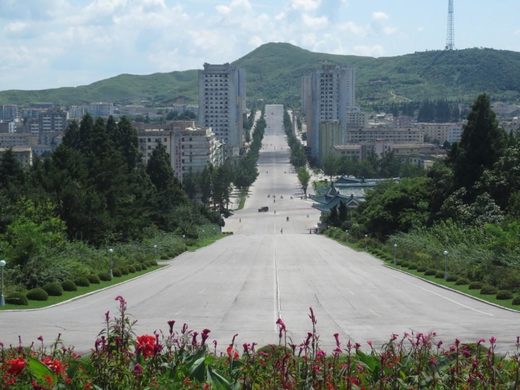
One morning near the end of our trip, we piled on the bus and headed toward Kaesong, the town on the edge of the Demilitarized Zone between North and South Korea, better known as the DMZ.
I had read many reports about people visiting the DMZ from South Korea, where plentiful military checkpoints from South Korean and US troops give a sense of gravity to the trip. There are lots of rules to follow, and your guides emphasize the severity of the situation at every step along the way. Oddly enough, visiting the North Korean side is much more relaxed, if only because there are far fewer visitors, and the stakes are a little bit lower for the DPRK having a tourist accidentally cause an international incident.
A short trip south of Kaesong, the border sits on a small abandoned village called Panmunjom, a historic town which has mostly been destroyed, apart from a small house converted into the Orwellian-named Peace Museum on the North's side. Nearby is the actual military demarcation line, called the Joint Security Area, where soldiers from the North and South famously stare each other down, and where occasional diplomatic summit meetings occur.
We drove through a few checkpoints, stopping frequently along the way. We seemed to be slowed down mostly because the area was swarming with Chinese tour groups, who have a tendency to move in large packs and have a reputation in traveller circles for being loud and obnoxious in inappropriate situations. The DMZ was no exception, and people in my group were getting visibly irritated with the Chinese groups taking the situation so lightly.
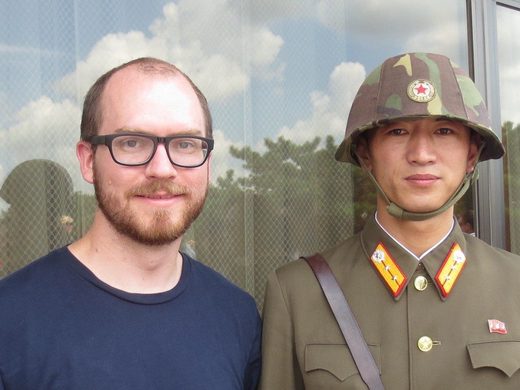
Despite the loud tourists, the border had an air of seriousness about it that was pretty profound. The North and South alternate times when tourists are allowed to visit the Joint Security Area, so the view into South Korea just looked like a vacant smattering of buildings. I'm sure there were South Korean and US soldiers waiting just out of sight, but it was empty as far as we could see. I found it contemplative and almost meditative to be there, a country occupied and divided, largely in this position because two military mights won World War II in a fight against Japan, Korea's imperialist occupier. Nearly seventy years later, the impacts remain palpable.
Food & Drink
As we left the DMZ, we stopped again in the somber and quiet town of Kaesong for a special lunch featuring a North Korean specialty: dog soup.
I like dogs as much as the next guy, but people in the West are unaware of what street dogs in third-world countries are like: they are much more like wild animals, scrappy and terrifying, often rabid-seeming. Dogs in the first world are legitimate members of a family — cute, pampered, and carefree — and eating them sounds barbaric. Curiosity outweighed my sentimentality, so I did not hesitate ordering the soup. The dog meat was gamey and tough, and the soup was spiced aggressively, almost too spicy to eat, but I carried on — that is, until a tourist at a nearby table discovered a canine tooth in his broth, at which point I gagged and had to stop eating immediately. I shudder just thinking about it.
Dog was only the tip of the iceberg when it came to nasty food in North Korea. Apart from a handful of genuinely delicious meals, eating felt like being on an episode of Fear Factor. Waitresses would bring out bowl after bowl of nearly-inedible craziness, and since there were no other options, I ate pretty much everything. I remember during one meal I was relieved to be presented a bowl of what looked like finely minced greens, perhaps seaweed. Vegetables! It was a revelation! Then I looked closer. It was a big bowl of tiny dried eels, intensely salty and crunchy to the bite.
Almost all meals came with kimchi, Korea's national dish of fermented vegetables. I was skeptical of kimchi prior to my trip, but I actually found myself enjoying trying the kimchi at every meal, because there is a surprising amount of nuance and difference from one kimchi to the next. Sometimes spicy and bitter, sometimes mild and sweet, sometimes insanely fermented to the point where it tastes funky and rotten. Even the worst kimchi was decent, however.
There were a few culinary highlights, like the day we got a nice bowl of bibimbap, rice topped with chili paste, vegetables, meat, and an over-easy egg. I also liked the pansangi, an array of more than a dozen small tastes served in bronze bowls. We were also treated to several meals of Korean barbecue, cooked to your liking over hot coals right at the table. Unlike many meals we had, the barbeque was legitimately delicious.
One afternoon we were treated to a rare meal outdoors, eating barbecue in a park alongside dozens of families, each squatting and chatting around a fire cooking up a delicious meal for themselves. I loved wandering through the park watching these families chat, cook, and joke with each other.
Unlike in the west, restaurants were hard to spot from the street, and were rarely on the ground floor. In our official tour itinerary, most restaurants were described as being "famous" in one way or another, but almost all of them felt like obscure holes-in-the-wall, largely in existence for tourist purposes, although there were often a handful of local people eating too. Unquestionably the weirdest meal we ate was one at a place called Pizza Restaurant, which purportedly has staff trained by pizza experts from Italy. Like most third-world pizzas I've eaten, it was totally bizarre, borderline inedible, and topped with a mismatch of ingredients like pineapple, black olives, and hard-boiled eggs. Other dinners featured charmingly awkward performances sung by accordion-wielding waitstaff.
Surprisingly, the drink situation in the country is not bad. The country has a weird little microbrew scene, and in addition to the standard bland Asian lagers on offer, our hotel served a steam beer that tasted roughly like San Francisco's well-known Anchor Steam. It was a pleasant surprise, given that Asian beer has a tendency to be uniformly boring.
In nearby Sariwon City, we stopped by a place specializing in a more obscure traditional drink called makgeolli, a mixture made with boiled and fermented white rice, containing about 6% alcohol. It was somewhat like Japanese sake, but to me tasted a bit sweeter, considerably less filtered, and with a more pronounced sour funk from the fermentation. Compared to the rest of my group, I found the beverage fairly delicious and interesting, but we all agreed that the act of drinking makgeolli is unnerving because there is no escaping that it looks like a massive bowl of semen.
The Mass Games
Toward the end of our seven day tour, we broke from our routine by attending the world-famous Mass Games, also called Arirang, a spectacle which felt almost like a cross between a political rally and an Olympic Opening Ceremony.
We were all excited about the Mass Games. The dramatic spectacle was featured in documentaries I had seen about North Korea, and is billed by tour guides as one of the highlights of a trip to the country. The event only happens during the early fall, and only in the random years when the DPRK decides to hold it. Many foreigners time their visits to see the Mass Games, myself included.
The Mass Games are held in May Day stadium, the largest in the world, with a capacity of 150,000 visitors. The name of the event, officially the Grand Mass Gymnastics and Artistic Performance Arirang, is in reference to a national folk song called Arirang, about a young couple split apart by their landlord, a symbolic nod to the division of Korea itself. As we drove through the night toward the stadium, our guide told the story of the couple, and even proudly sang us the folk song. She told us that while the games seem like entertainment and spectacle on the surface, they are primarily intended to celebrate the history of the Korean peninsula and the DPRK itself.
Our bus parked and we piled out into a packed plaza in front of the stadium, swarming with military soldiers, normal citizens, and even performers from the Mass Games itself, getting in some last minute practice for their part in the show, or getting encouragement from their proud families. There was a incredible buzz of nervous excitement in the air; it reminded me of going with my dad to Denver Broncos games as a kid, in awe of the fanfare surrounding seeing such a spectacle in person.
Our tickets were ripped and we were led to a special section intended only for foreigners and guides. Tickets were available at wildly different price points for different sections, but I couldn't tell the difference between a good or bad seat — they all seemed pretty good to me.
Across the green velvet floor, there was a steep seating area where thousands of kids were perched, each playing an integral part in the Arirang festivities by literally forming the backdrop of the event. Arriving twenty minutes before the show started, we got the privilege of seeing their last-minute practice, flipping books of colored cards at just the right moment so that each kid's individual pixel of color coalesced into a massive image.
A man yelled into a bullhorn and the kids flipped their cards accordingly, shouting confirmation back to him like tiny soldiers obeying a drill sergeant. It was remarkable. The kids are plucked from schools at a young age to get them well-practiced flipping cards for the Mass Games, which is apparently somewhat controversial among parents in Pyongyang.
Along with the constantly changing backdrop, the show had dancers, a karate performance, flag wavers, gymnasts, and acrobats, each coming and going in rapid succession, one after the next. The level of coordination involved in the event was truly impressive.
I was surprised how nervous I felt during the whole show. I was like I had snuck into a secret performance inside a hidden socialist empire — like I wasn't supposed to be seeing what I was seeing. And in an sense, I had.
Lasting Impressions
Before I left, I had read Sophie Schmidt's feeling that North Korea was akin to a large-scale version of The Truman Show, where people are living in a society that is so controlled that it eclipses any perspective of the outside:
Ordinary North Koreans live in a near-total information bubble, without any true frame of reference. I can't think of any reaction to that except absolute sympathy. My understanding is that North Koreans are taught to believe they are lucky to be in North Korea, so why would they ever want to leave? They're hostages in their own country, without any real consciousness of it. And the opacity of the country's inner workings—down to the basics of its economy—further serves to reinforce the state's control. The best description we could come up with: it's like The Truman Show, at country scale.The comparison is apt. Traveling in the country as an outsider, however, did not feel like being a part of a complex hoax or the lone audience member in elaborate play. Instead, visiting North Korea felt like time traveling, as if we had turned back the clock to around 1950 or 60 when Korea began to isolate itself from outside influence.
Comment: Ok, in one sense, it is. In another, it isn't. North Koreans are informed about more than just 'what the US did to our country' - they're informed about what the US (and others) did and does all over the world. So who's living in The Truman Show now?
For better or worse, capitalism is a relentless pursuit of the new, and North Korea felt like a society relatively uninterested in newness, or at least unaware of how far other societies have come. I was a digital person in an analog society, and I was surprised how jarring it felt. There were very few computers, no internet, no credit cards, no iPhones. Clothing was dated, ill-fitting, and formal. Trams and buses felt rickety, and housing felt repressive and ramshackle.
There were also curiosities I did not expect: apart from government propaganda posters, there was no advertising to be found anywhere. Buildings lacked garish signage, streets lacked billboards, and magazines lacked ads. It made me realize how much visual pollution exists in the modern capitalist world. To a North Korean, anywhere else must look as garish as Times Square. As gigantic as Pyongyang was, these aspects made it feel almost charming or quaint.
Paradoxically, the North felt like a totally stable country, yet also one teetering on the edge of collapse. The country is a grand experiment in socialism, a mentality largely abandoned by the DPRK's allies China and Russia to a degree that North Koreans do not even seem to know about. Even within the country, markets are forming on the fringes, and hardline socialist policies are becoming slightly more lax. Reports of people wearing Chinese or South Korean fashions indicate a somewhat permeable border, and suggest a citizenry more aware of the relative luxury, wealth, and personal freedoms that exist for people nearby. Defectors living in Seoul or Beijing have underground means to get information in and out the DPRK.
It is hard to know what the future of North Korea will be. Outside observers with ties to the country claim that the young leader Kim Jong Un is weak and untrusted among the country's elite, potentially even toppled in a coup d'etat already, held up as a puppet figurehead to keep appearances of the Kim Dynasty alive. Still, citizens and the government alike call for national reunification of the entire Korean peninsula with Pyongyang as the capital, rather than Seoul, suggesting people remain a bit delusional.
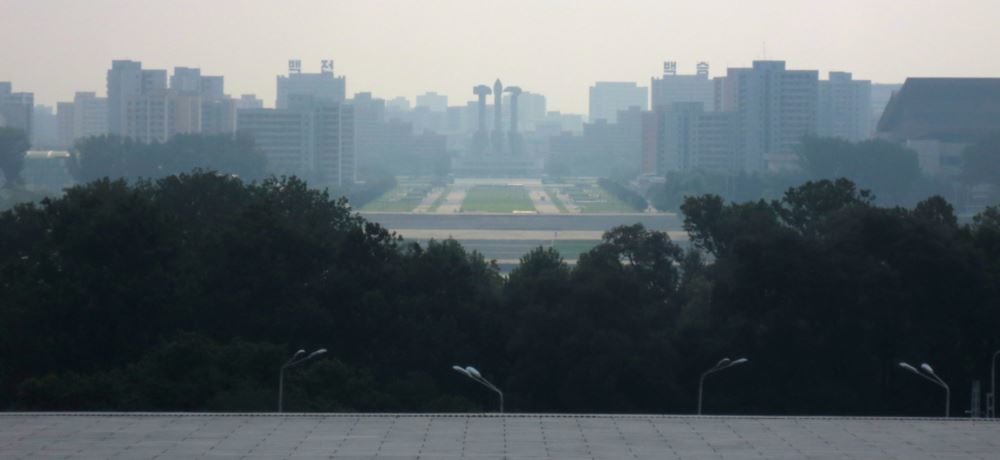
Wandering the streets, I thought about a North Korean person experiencing Seoul for the first time. It would be a shock. Bright signs with chunky hangul writing flash and blink everywhere. There is a mix of ethnicities and languages around on every block. In neighborhoods like Gangnam, grown women dress like hyper-sexualized dolls, and subversive behavior is not only tolerated, but encouraged. Wacky pop music from bands like Crayon Pop blasts from speakers all around town. There are offbeat coffee shops populated with kittens or puppies, a new trend aimed at the South Korean love of cuteness.
Comment: They're not exactly positives.
Food choices in Seoul are about as international as they get. The complex and efficient subway would make Pyongyang's look rickety and quaint. Perhaps unsurprisingly, North Korean defectors who have made it to China or South Korea have had a rough time assimilating.
It will be fascinating to see what happens to the Hermit Kingdom as its reclusive leaders make choices on behalf of the DPRK's citizens over the next ten or twenty years. My guess is that the country is in for a rude awakening and painful transition as the pressure join the modern world becomes too strong to ignore.
All photographs were taken by me, unless attributed to a different source. I am not an expert on North Korea by any means, so please take my views with a grain of salt. Like in any country, every traveler's experience will be different, with only a few truths tying them all together. Thank you so much for reading this far.
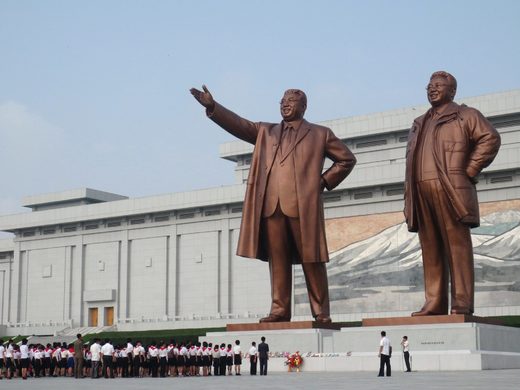
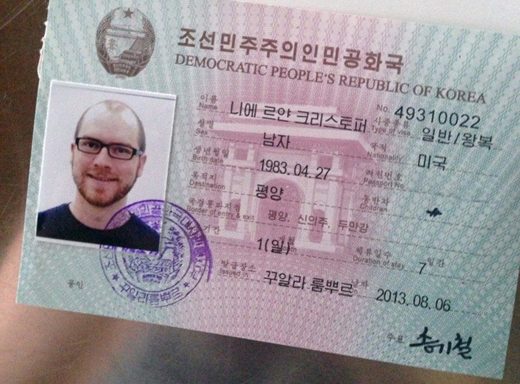
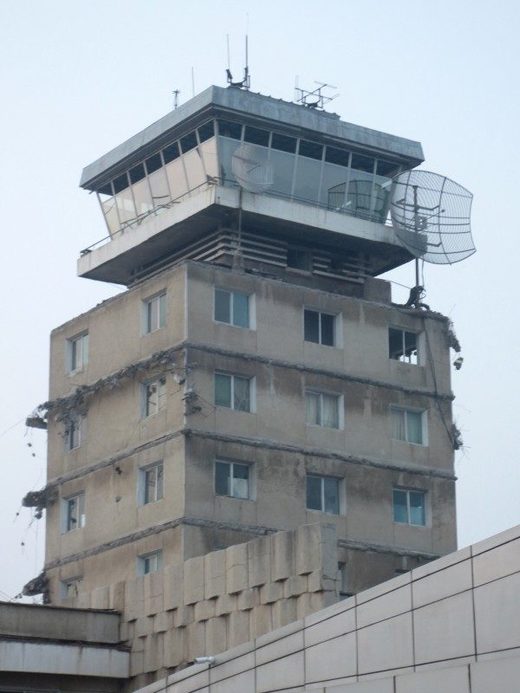
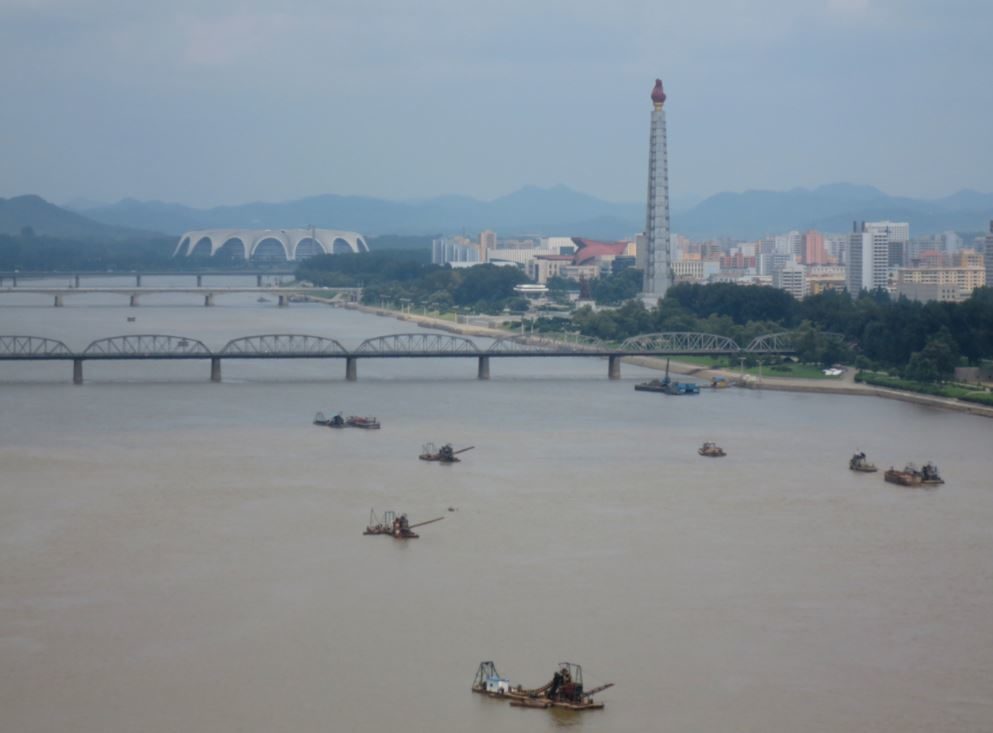
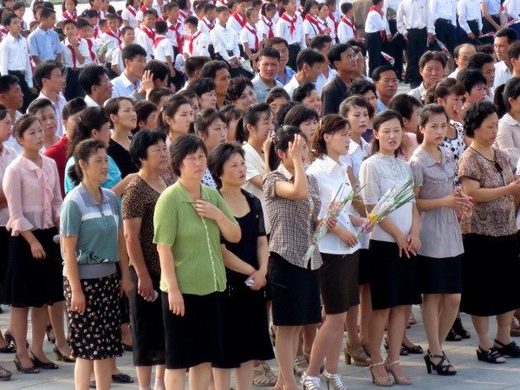
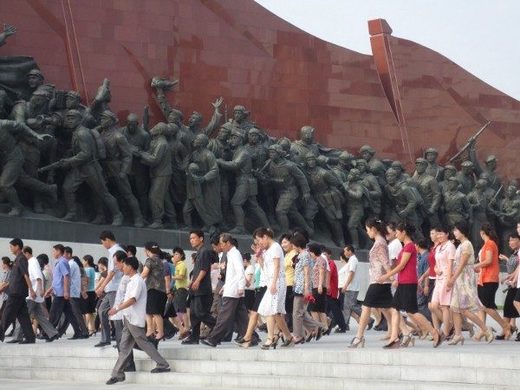
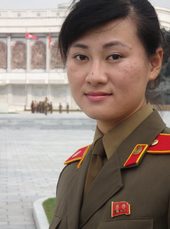
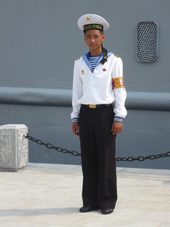
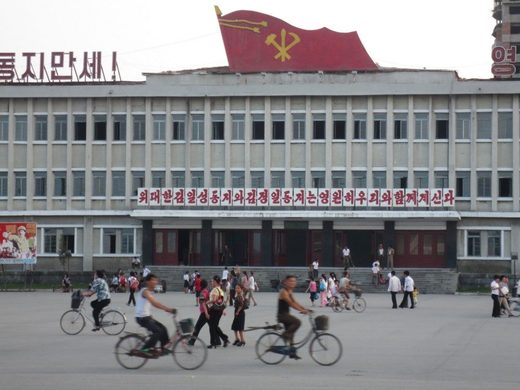
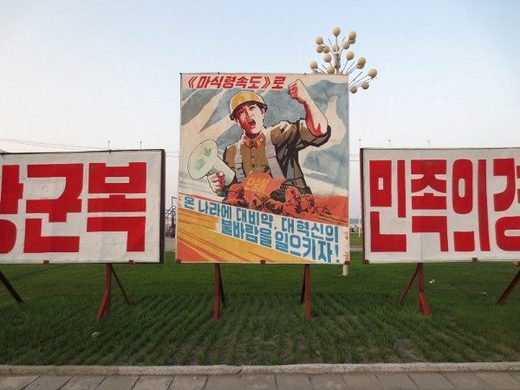
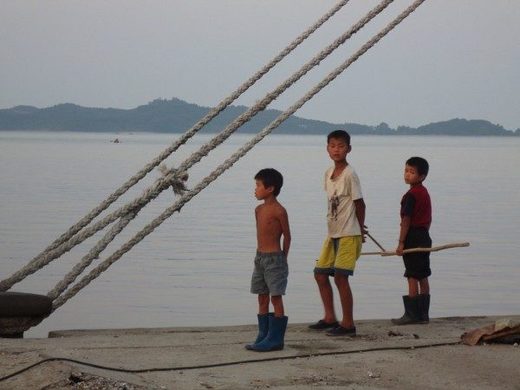
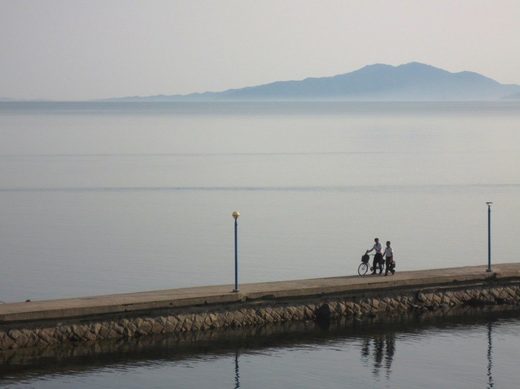
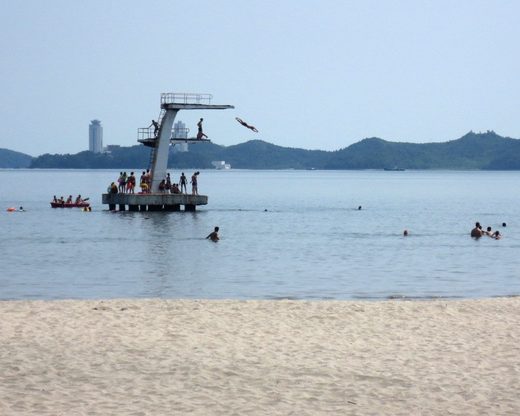
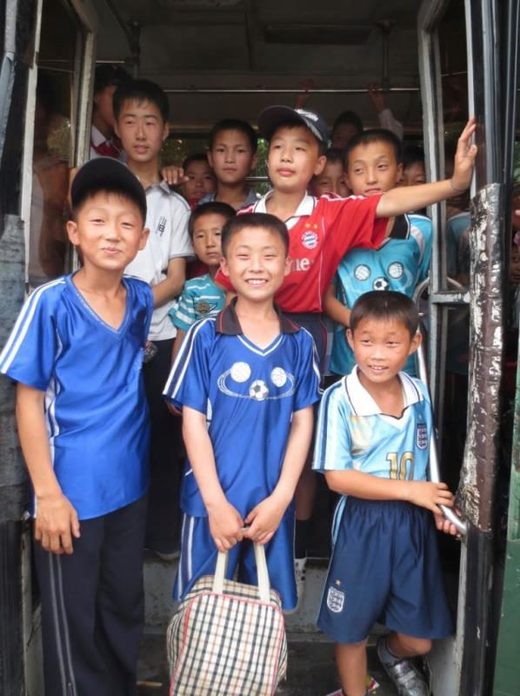
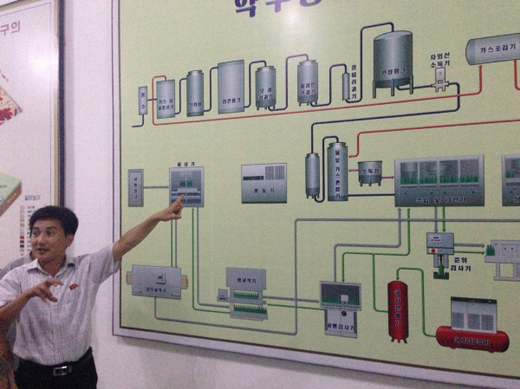
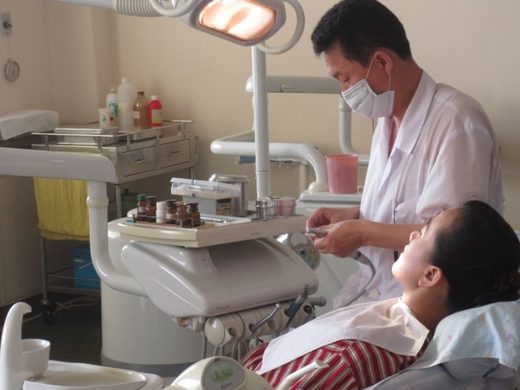
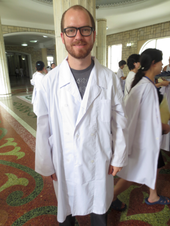
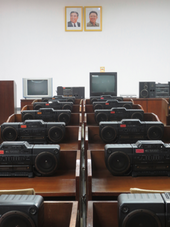
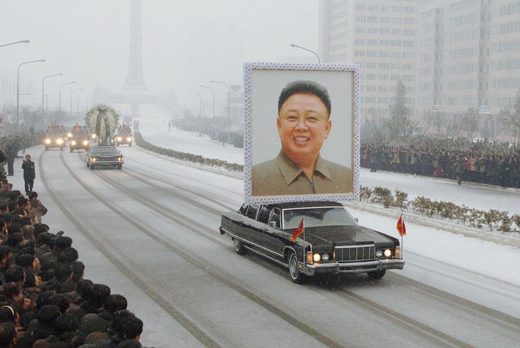
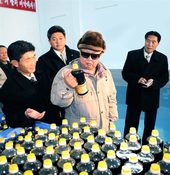
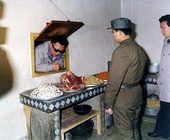
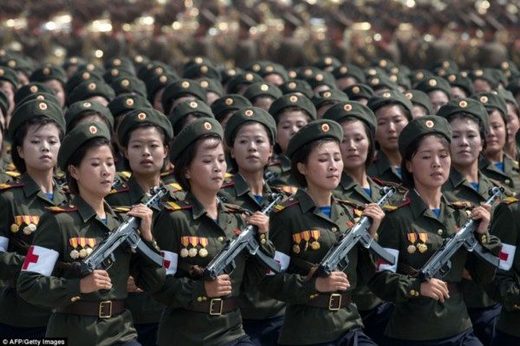
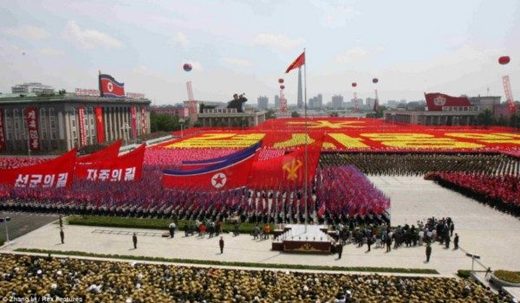
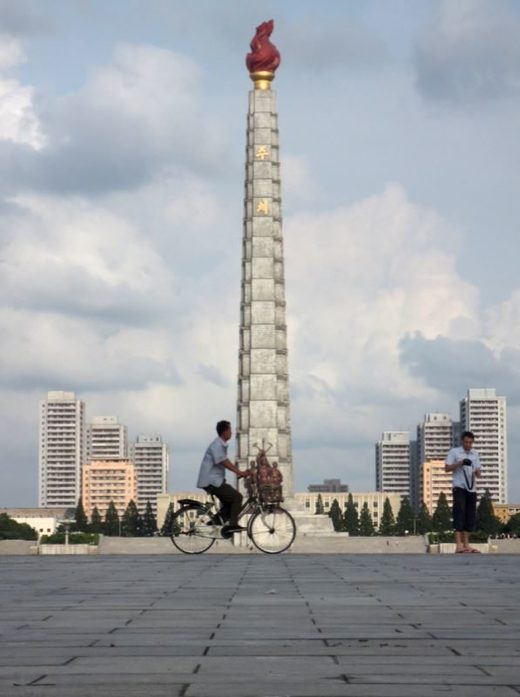
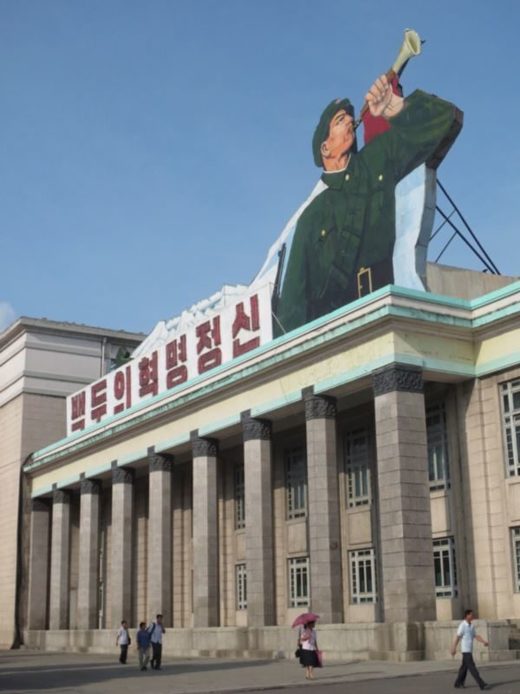

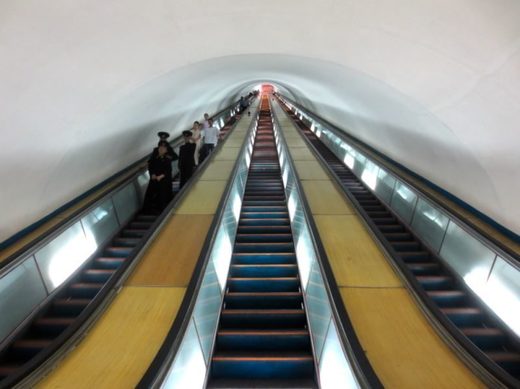
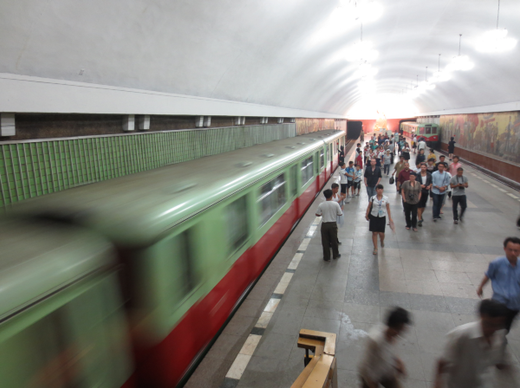
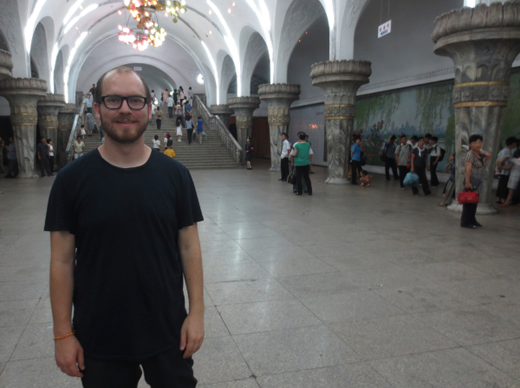
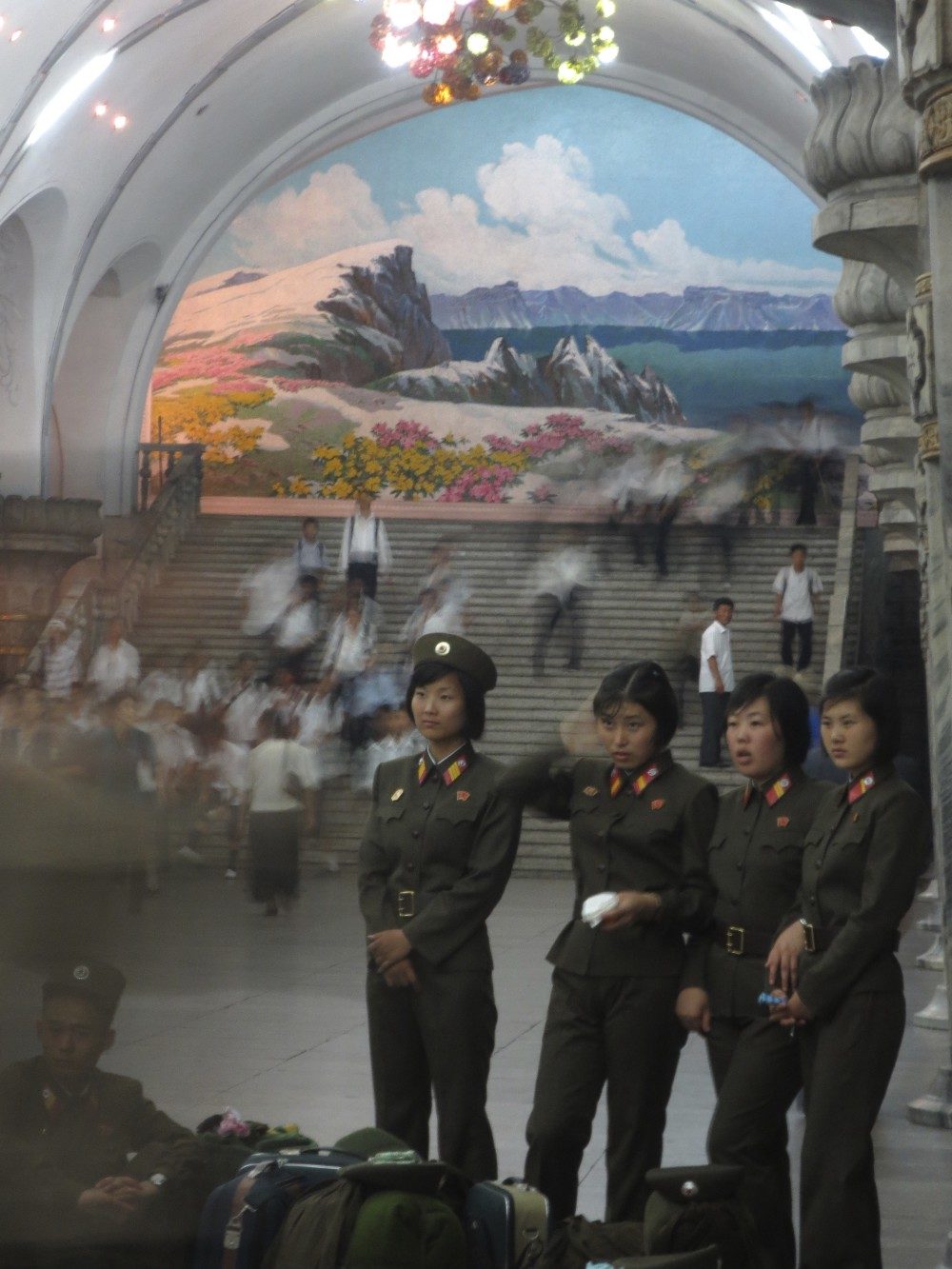
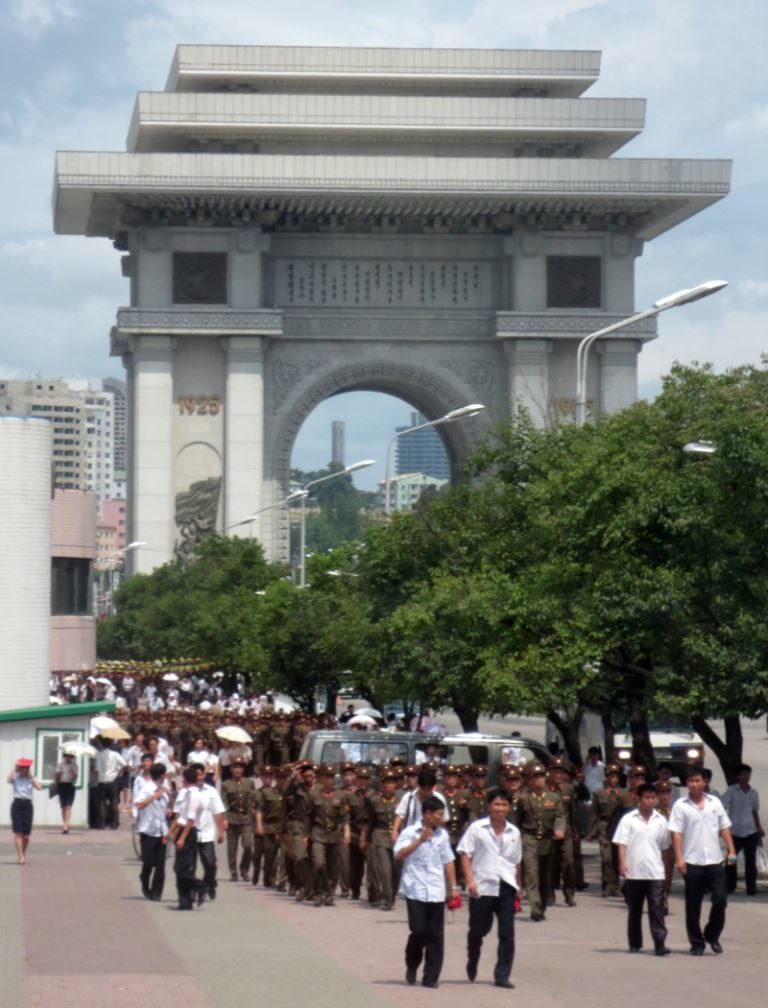
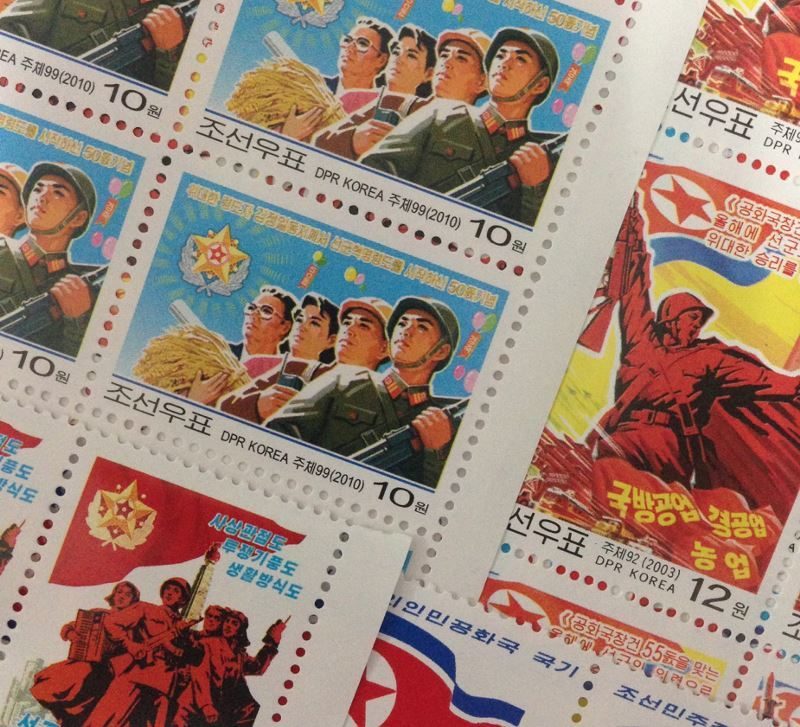
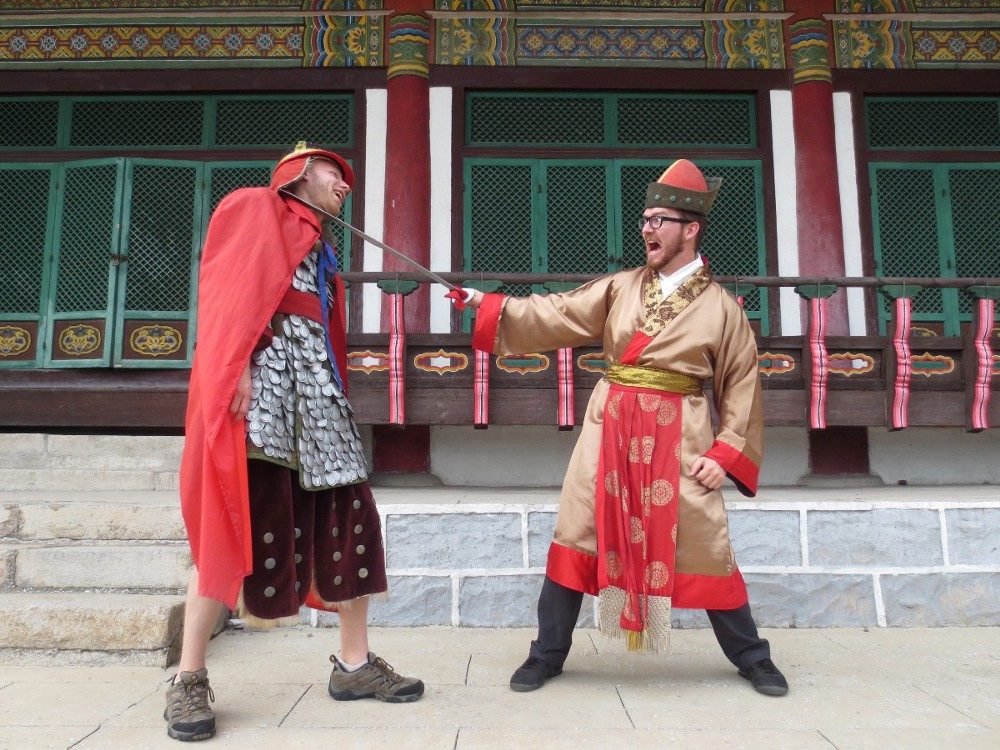
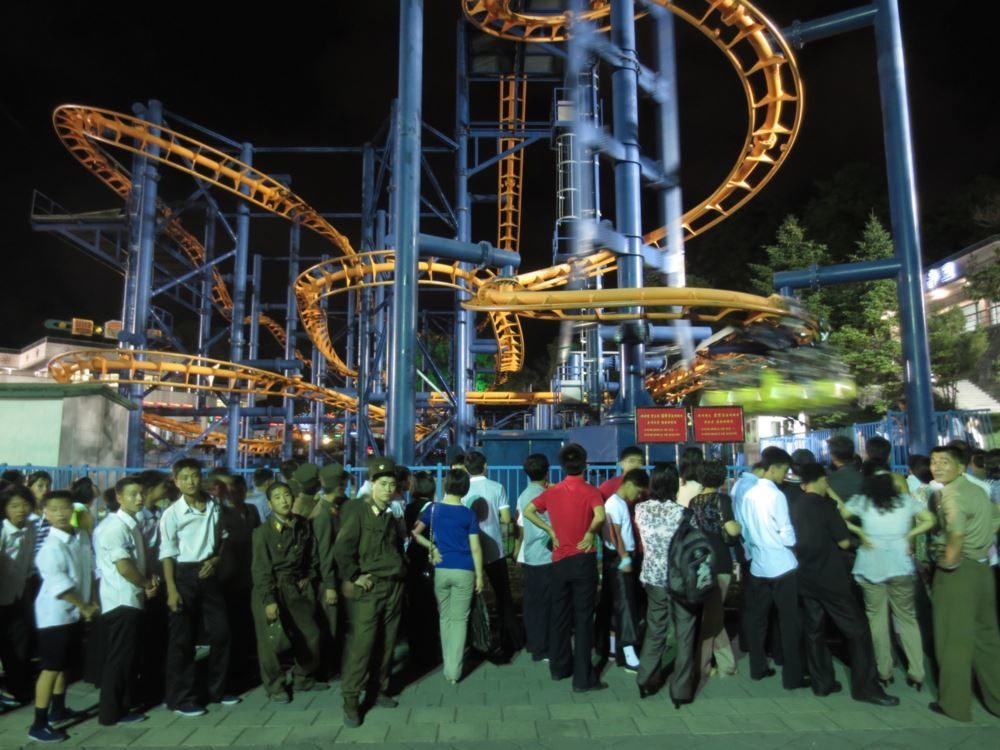

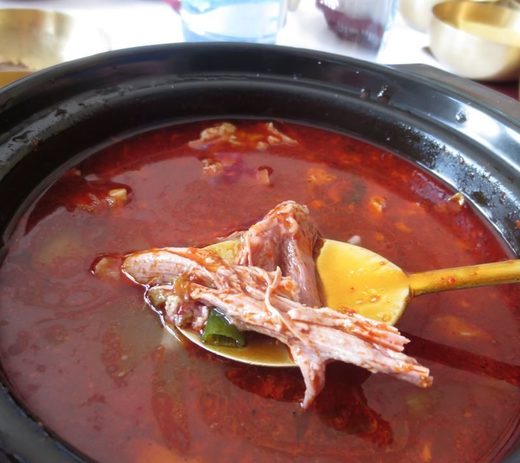
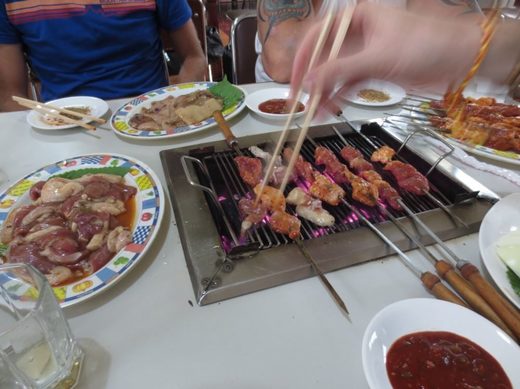
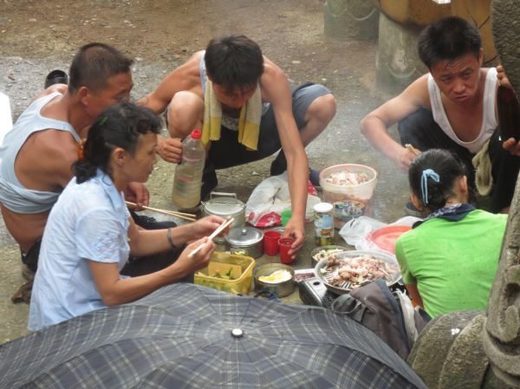
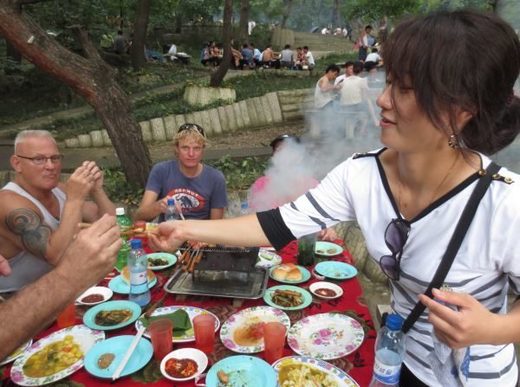
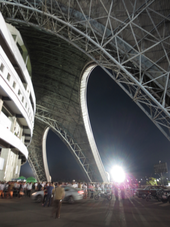
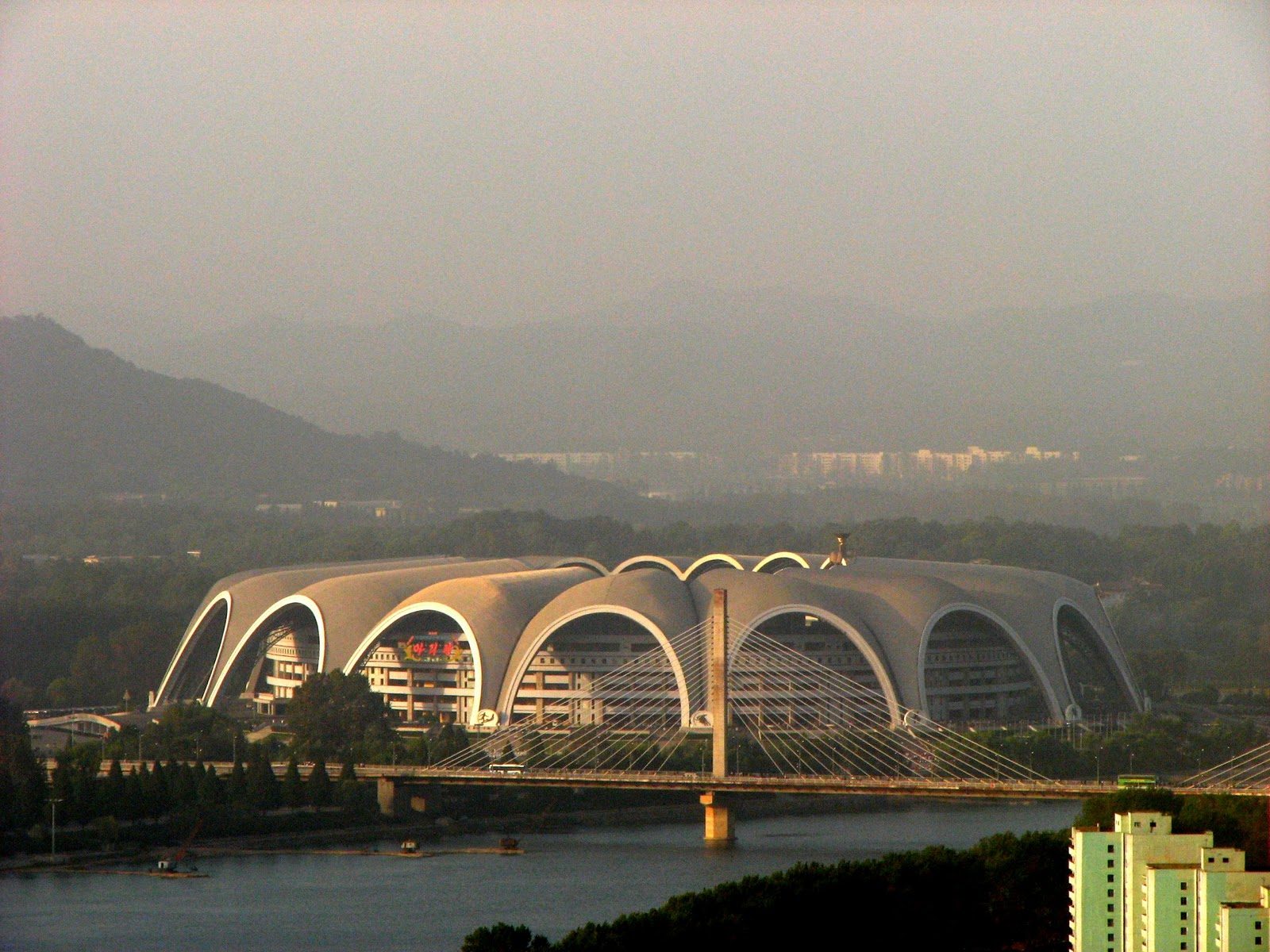

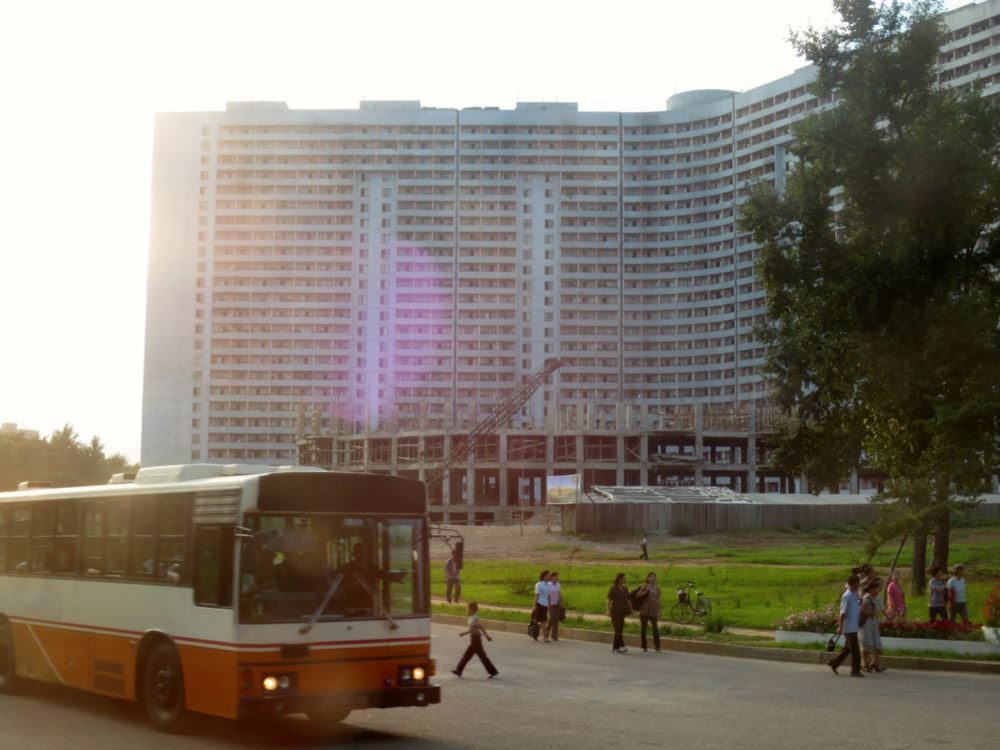



Comment: North Korea will open up, but it won't do so on America's terms. At least, not the deep state's terms. Its leaders have actually made countless overtures to US officials over the years and decades...